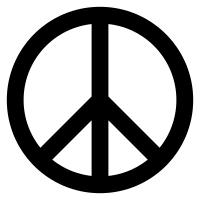The Troubles
The Troubles (Irish: Na Trioblóidí) was an ethno-nationalist[13][14][15][16] conflict in Northern Ireland during the late 20th century. Also known internationally as the Northern Ireland conflict,[17][18][19][20] it is sometimes described as an "irregular war"[21][22][23] or "low-level war".[24][25][26] The conflict began in the late 1960s and is usually deemed to have ended with the Good Friday Agreement of 1998.[2][3][27][28][29] Although the Troubles primarily took place in Northern Ireland, at times the violence spilled over into parts of the Republic of Ireland, England, and mainland Europe.
| The Troubles | ||||||||
|---|---|---|---|---|---|---|---|---|
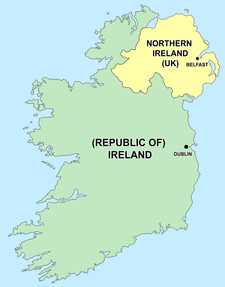 Political map of Ireland | ||||||||
| ||||||||
| Belligerents | ||||||||
| State security forces: | Irish republican paramilitaries: |
Ulster loyalist paramilitaries:
| ||||||
| Casualties and losses | ||||||||
|
British Army: 705 Irish Army: 1 Gardaí: 9 IPS: 1 Total: 11[7] |
PIRA: 292 INLA: 38 OIRA: 27 IPLO: 9 RIRA: 2 Total: 368[7] 8,000+ arrested[8] |
UDA: 91 UVF: 62 RHC: 4 LVF: 3 UR: 2 UPV: 1 [9] Total: 162[7] | ||||||
|
Civilians killed: 1,840[10] (or 1,935 inc. ex-combatants)[7] | ||||||||
The conflict was primarily political and nationalistic, fuelled by historical events.[30] It also had an ethnic or sectarian dimension,[31] but despite the use of the terms "Protestant" and "Catholic" to refer to the two sides, it was not a religious conflict.[13][32] A key issue was the constitutional status of Northern Ireland. Unionists, who were mostly Ulster Protestants, wanted Northern Ireland to remain within the United Kingdom. Irish nationalists, who were mostly Irish Catholics, wanted Northern Ireland to leave the United Kingdom and join a united Ireland.
The conflict began during a campaign by the Northern Ireland Civil Rights Association to end discrimination against the Catholic/nationalist minority by the Protestant/unionist government of Northern Ireland and Royal Ulster Constabulary (RUC).[33][34] The authorities attempted to suppress the protest campaign with police brutality; it was also met with violence from loyalists, who believed it was a republican front. Increasing tensions led to severe violence in August 1969 and the deployment of British troops, in what became the British Army's longest ever operation.[35] 'Peace walls' were built in some areas to keep the two communities apart. Some Catholics initially welcomed the British Army as a more neutral force than the RUC, but it soon came to be seen as hostile and biased, particularly after Bloody Sunday in 1972.[36] Armed paramilitary organisations joined the fray, quickly becoming the most violent actors in the conflict.
The main participants in the Troubles were republican paramilitaries such as the Provisional Irish Republican Army (IRA) and the Irish National Liberation Army (INLA); loyalist paramilitaries such as the Ulster Volunteer Force (UVF) and Ulster Defence Association (UDA); British state security forces—the British Army and RUC; and political activists and politicians. The security forces of the Republic of Ireland played a smaller role. Republican paramilitaries carried out a guerrilla campaign against British security forces as well as a bombing campaign against infrastructural, commercial and political targets. Loyalists targeted republicans/nationalists and attacked the wider Catholic community in what they described as retaliation. At times, there were bouts of sectarian tit-for-tat violence, as well as feuds within and between paramilitary groups of the same stripe. The British security forces undertook both a policing and counter-insurgency role, primarily against republicans. There were some incidents of collusion between British security forces and loyalist paramilitaries. The Troubles also involved numerous riots, mass protests and acts of civil disobedience, and led to increased segregation and the creation of no-go areas.
More than 3,500 people were killed in the conflict, of whom 52% were civilians, 32% were members of the British security forces and 16% were members of paramilitary groups.[7] Republican paramilitaries were responsible for some 60% of the deaths, loyalists 30% and security forces 10%.[37] There has been sporadic violence since the Good Friday Agreement was signed, including ongoing punishment attacks[38] and a campaign by dissident republicans.[3][28][39]
Overview
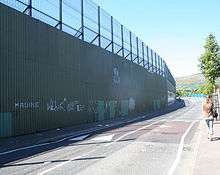
"The Troubles" refers to the three-decade conflict between nationalists (mainly self-identified as Irish or Roman Catholic) and unionists (mainly self-identified as British or Protestant). The word "troubles" has been used as a synonym for violent conflict for centuries.[lower-alpha 1] The term was used to describe the Irish revolutionary period in the early twentieth century.[40] It was subsequently adopted to refer to the escalating violence in Northern Ireland after 1969.[41][42][43][44] The violence was characterised by the armed campaigns of Irish republican and Ulster loyalist paramilitary groups and British state security forces (the British Army and the Royal Ulster Constabulary (RUC)). It thus became the focus for the longest major campaign in the history of the British Army.[45][46]
The British government's position is that its forces were neutral in the conflict, trying to uphold law and order in Northern Ireland and the right of the people of Northern Ireland to democratic self-determination. Nationalists regarded the state forces as forces of occupation or partisan combatants in the conflict, while Unionists tended to support the locally recruited RUC. The British security forces focused on republican paramilitaries and activists, and the "Ballast" investigation by the Police Ombudsman confirmed that certain British officers colluded on several occasions with loyalist paramilitaries, were involved in murder, and furthermore obstructed the course of justice when claims of collusion and murder were investigated.[47]
The Troubles were brought to an uneasy end by a peace process that included the declaration of ceasefires by most paramilitary organisations, the complete decommissioning of the IRA's weapons, the reform of the police, and the withdrawal of the British Army from the streets and sensitive Irish border areas such as South Armagh and County Fermanagh, as agreed by the signatories to the Belfast Agreement (commonly known as the "Good Friday Agreement"). One part of the Agreement is that Northern Ireland will remain within the United Kingdom unless a majority of the Northern Irish electorate vote otherwise.[48] It also established the Northern Ireland Executive, a devolved power-sharing government, which must consist of both unionist and nationalist parties.
Although the number of active participants was relatively small, the Troubles affected many in Northern Ireland on a daily basis; their impact sometimes spread to England and the Republic of Ireland, and, occasionally, to parts of mainland Europe.[49]
Peace lines, which were built in Northern Ireland during the early years of the Troubles, remain in place.[50]
Background
1609–1791
_tussen_Jacobus_II_en_Willem_III%2C_12_juli_1690_Rijksmuseum_SK-A-605.jpeg)
In 1609, Scottish and English settlers, known as planters, were given land escheated from the native Irish in the Plantation of Ulster.[51] Coupled with Protestant immigration to "unplanted" areas of Ulster, particularly Antrim and Down, this resulted in conflict between the native Catholics and the "planters", leading in turn to two bloody religious conflicts known as the Irish Confederate Wars (1641–1653) and the Williamite war (1689–1691), both of which resulted in Protestant victories.
Anglican dominance in Ireland was ensured by the passage of the Penal Laws that curtailed the religious, legal, and political rights of anyone (including both Catholics and Protestant Dissenters, such as Presbyterians) who did not conform to the state church, the Anglican Church of Ireland. As the Penal Laws started to be phased out in the latter part of the 18th century, there was more competition for land, as restrictions were lifted on the Irish Catholic ability to rent. With Roman Catholics allowed to buy land and enter trades from which they had formerly been banned, tensions arose resulting in the Protestant "Peep O'Day Boys"[52] and Catholic "Defenders". This created polarisation between the communities and a dramatic reduction in reformers among Protestants, many of whom had been growing more receptive to democratic reform.[52]
1791–1912
Following the foundation of the republican Society of the United Irishmen by Presbyterians, Catholics, and liberal Anglicans, and the resulting failed Irish Rebellion of 1798, sectarian violence between Catholics and Protestants continued. The Orange Order (founded 1795), with its stated goal of upholding the Protestant faith and loyalty to the heirs of William of Orange, dates from this period and remains active to this day.[53]
With the Acts of Union 1800 (which came into force on 1 January 1801), a new political framework was formed with the abolition of the Irish Parliament and incorporation of Ireland into the United Kingdom of Great Britain and Ireland. The result was a closer tie between Anglicans and the formerly republican Presbyterians as part of a "loyal" Protestant community. Although Catholic emancipation was achieved in 1829, largely eliminating official discrimination against Roman Catholics (then around 75% of Ireland's population), Dissenters, and Jews, the Repeal Association's campaign to repeal the 1801 Union failed.
In the late 19th century, the Home Rule movement was created and served to define the divide between most nationalists (usually Catholics), who sought the restoration of an Irish Parliament, and most unionists (usually Protestants), who were afraid of being a minority under a Catholic-dominated Irish Parliament and who tended to support continuing union with Britain.
Unionists and Home Rule advocates were the main political factions in late 19th- and early 20th-century Ireland.[54]
1912–1922
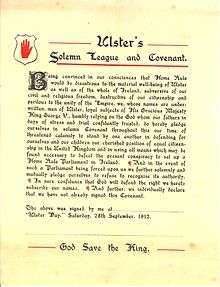
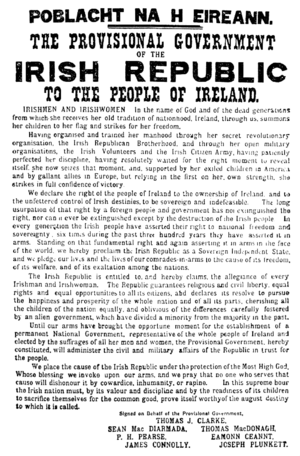
By the second decade of the 20th century, Home Rule, or limited Irish self-government, was on the brink of being conceded due to the agitation of the Irish Parliamentary Party. In response to the campaign for Home Rule which started in the 1870s, unionists, mostly Protestant and largely concentrated in Ulster, had resisted both self-government and independence for Ireland, fearing for their future in an overwhelmingly Catholic country dominated by the Roman Catholic Church. In 1912, unionists led by Edward Carson signed the Ulster Covenant and pledged to resist Home Rule by force if necessary. To this end, they formed the paramilitary Ulster Volunteer Force (UVF).[55]
In response, nationalists led by Eoin MacNeill formed the Irish Volunteers in 1913, whose goal was to oppose the UVF and ensure enactment of the Third Home Rule Bill in the event of British or unionist recalcitrance. The outbreak of the First World War in 1914, and Ireland's involvement in the war, temporarily averted possible civil war in Ireland and delayed the resolution of the question of Irish independence. Home Rule, although passed in the British Parliament with Royal Assent, was suspended for the duration of the war.
The Irish Volunteers split, with a majority, known as the National Volunteers, supporting the war effort, and some of them joining Irish regiments of the New British Army. Many of those who stayed were radical nationalists, among them Irish Republican Brotherhood infiltrators. From these ranks came those who launched the Easter Rising in Dublin in 1916, led by Padraig Pearse and James Connolly. Two-and-a-half years after the executions of sixteen of the Rising's leaders, the separatist Sinn Féin party won the December 1918 general election in Ireland with 47% of the vote and a majority of seats, and set up the 1919 First Dáil (Irish Parliament) in Dublin. Their victory was aided by the threat of conscription for First World War service. The Irish War for Independence followed, leading to eventual independence in 1922 for the Irish Free State, which comprised 26 of the 32 Irish counties. In Ulster, particularly in the six counties which became Northern Ireland, Sinn Féin fared relatively poorly in the 1918 election, and unionists won a majority.[55]
The Government of Ireland Act 1920 partitioned the island of Ireland into two separate jurisdictions, Southern Ireland and Northern Ireland, both devolved regions of the United Kingdom. This partition of Ireland was confirmed when the Parliament of Northern Ireland exercised its right in December 1922 under the Anglo-Irish Treaty of 1921 to "opt out" of the newly established Irish Free State.[48] A part of the treaty signed in 1922 mandated that a boundary commission would sit to decide where the frontier of the northern state would be in relation to its southern neighbour. After the Irish Civil War of 1922–1923, this part of the treaty was given less priority by the new Dublin government led by W. T. Cosgrave, and was quietly dropped. As counties Fermanagh and Tyrone and border areas of Londonderry, Armagh, and Down were mainly nationalist, the Irish Boundary Commission could reduce Northern Ireland to four counties or less.[55]
Northern Ireland remained a part of the United Kingdom, albeit under a separate system of government whereby it was given its own parliament and devolved government. While this arrangement met the desires of unionists to remain part of the United Kingdom, nationalists largely viewed the partition of Ireland as an illegal and arbitrary division of the island against the will of the majority of its people. They argued that the Northern Ireland state was neither legitimate nor democratic, but created with a deliberately gerrymandered unionist majority. Catholics initially composed about 35% of its population.[56] A total of 557 people, mostly Catholics, were killed in political or sectarian violence from 1920 to 1922 in the six counties that would become Northern Ireland, both during and after the Irish War of Independence.[57] The result was[58] communal strife between Catholics and Protestants, with some historians describing this violence, especially that in Belfast, as a pogrom,[59][60] although historian Peter Hart argues that the term is not appropriate given the reciprocity of violence in Northern Ireland.[61]
1922–1966
.jpg)
A marginalised remnant of the Irish Republican Army survived the Irish Civil War. This would come to have a major impact on Northern Ireland. Although the IRA was proscribed on both sides of the new Irish border, it remained ideologically committed to overthrowing both the Northern Ireland and the Free State governments by force of arms to unify Ireland. The government of Northern Ireland passed the Special Powers Act in 1922, giving sweeping powers to the government and police to intern suspects without trial and to administer corporal punishment such as flogging to re-establish or preserve law and order. The Act continued to be used against nationalists long after the violence of this period had come to an end.[62] In 1920, in local elections held under proportional representation, nationalists had won control over many local governments, including the County Councils of Fermanagh and Tyrone, and the Londonderry Borough Council governing Derry City. In response, in 1922 the new unionist government re-drew the electoral boundaries to give its supporters a majority and abolished proportional representation in favour of first past the post voting. This resulted in unionist control of areas such as Derry City, Fermanagh, and Tyrone where they were actually a minority of voters.[63]
The two sides' positions became strictly defined following this period. From a unionist perspective, Northern Ireland's nationalists were inherently disloyal and determined to force unionists into a united Ireland. This threat was seen as justifying preferential treatment of unionists in housing, employment and other fields. The prevalence of larger families and thus the potential for a more rapid population growth among Catholics was seen as a threat. Unionist governments ignored Edward Carson's warning in 1921 that alienating Catholics would make Northern Ireland inherently unstable. After the early 1920s, there were occasional incidents of sectarian unrest in Northern Ireland. These included severe rioting in Belfast in the 1930s and 1950s, and the IRA's brief Northern Campaign in the 1940s and Border Campaign between 1956 and 1962, which did not enjoy broad popular support among nationalists. After the IRA called off its campaign in 1962, Northern Ireland became relatively stable for a brief period.[55]
Late 1960s
There is little agreement on the exact date of the start of the Troubles. Different writers have suggested different dates. These include the formation of the modern Ulster Volunteer Force in 1966,[64] the civil rights march in Derry on 5 October 1968, the beginning of the 'Battle of the Bogside' on 12 August 1969 or the deployment of British troops on 14 August 1969.[55]
Civil rights campaign and unionist backlash
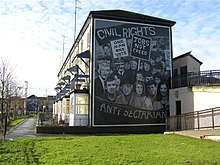
In March and April 1966, Irish nationalists/republicans held parades throughout Ireland to mark the 50th anniversary of the Easter Rising. On 8 March, a group of Irish republicans dynamited Nelson's Pillar in Dublin. At the time, the IRA was weak and not engaged in armed action, but some unionists warned it was about to be revived to launch another campaign against Northern Ireland.[65][66] In April 1966, loyalists led by Ian Paisley, a Protestant fundamentalist preacher, founded the Ulster Constitution Defence Committee (UCDC). It set up a paramilitary-style wing called the Ulster Protestant Volunteers (UPV)[65] to oust Terence O'Neill, Prime Minister of Northern Ireland. Although O'Neill was a unionist, they viewed him as being too 'soft' on the civil rights movement and opposed his policies.[67]
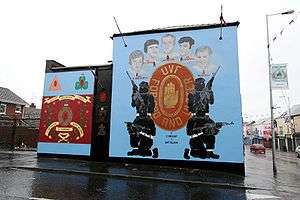
At the same time, a loyalist group calling itself the Ulster Volunteer Force (UVF) emerged in the Shankill area of Belfast. It was led by Gusty Spence, a former British soldier. Many of its members were also members of the UCDC and UPV.[68] In April and May 1966 it petrol bombed a number of Catholic homes, schools and businesses. A firebomb killed an elderly Protestant widow, Matilda Gould.[65] On 21 May, the UVF issued a statement declaring "war" against the IRA and anyone helping it.[69] The UVF fatally shot a Catholic civilian, John Scullion, as he walked home on 27 May. A month later it shot three Catholic civilians as they left a pub, killing Peter Ward, a Catholic from the Falls Road.[65][69] Shortly after, the UVF was proscribed by the Northern Ireland government.[65]
In the mid-1960s, a non-violent civil rights campaign began in Northern Ireland. It comprised groups such as the Northern Ireland Civil Rights Association (NICRA), the Campaign for Social Justice (CSJ), the Derry Citizens' Action Committee (DCAC) and People's Democracy,[70] whose stated goals were:
- an end to job discrimination – it showed evidence that Catholics/nationalists were less likely to be given certain jobs, especially government jobs
- an end to discrimination in housing allocation – it showed evidence that unionist-controlled local councils allocated housing to Protestants ahead of Catholics/nationalists
- one man, one vote – in Northern Ireland, only householders could vote in local elections, while in the rest of the United Kingdom all adults could vote
- an end to gerrymandering of electoral boundaries – this meant that nationalists had less voting power than unionists, even where nationalists were a majority
- reform of the police force (Royal Ulster Constabulary) – it was over 90% Protestant and criticised for sectarianism and police brutality
- repeal of the Special Powers Act – this allowed police to search without a warrant, arrest and imprison people without charge or trial, ban any assemblies or parades, and ban any publications; the Act was used almost exclusively against nationalists[71][65][72][73][74]
Some suspected and accused NICRA of being a republican front-group whose ultimate goal was to unite Ireland. Although republicans and some members of the IRA (then led by Cathal Goulding and pursuing a non-violent agenda) helped to create and drive the movement, they did not control it and were not a dominant faction within it.[55][75][76][77][78]
On 20 June 1968, civil rights activists (including Austin Currie, a nationalist MP) protested against housing discrimination by squatting in a house in Caledon. The local council had allocated the house to an unmarried 19-year-old Protestant (Emily Beattie, the secretary of a local UUP politician) instead of either of two large Catholic families with children.[79] RUC officers – one of whom was Beattie's brother – forcibly removed the activists.[79] Two days before the protest, the two Catholic families who had been squatting in the house next door were removed by police.[80] Currie had brought their grievance to the local council and to Stormont, but had been told to leave. The incident invigorated the civil rights movement.[81]
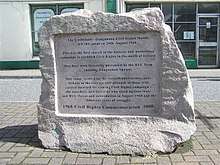
On 24 August 1968, the civil rights movement held its first civil rights march, from Coalisland to Dungannon. Many more marches were held over the following year. Loyalists (especially members of the UPV) attacked some of the marches and held counter-demonstrations in a bid to get the marches banned.[79] Because of the lack of police reaction to the attacks, nationalists saw the RUC, almost wholly Protestant, as backing the loyalists and allowing the attacks to occur.[82] On 5 October 1968, a civil rights march in Derry was banned by the Northern Ireland government.[83] When marchers defied the ban, RUC officers surrounded the marchers and beat them indiscriminately and without provocation. More than 100 people were injured, including a number of nationalist politicians.[83] The incident was filmed by television news crews and shown around the world.[84] It caused outrage among Catholics and nationalists, sparking two days of rioting in Derry between nationalists and the RUC.[83]
A few days later, a student civil rights group, People's Democracy, was formed in Belfast.[79] In late November, O'Neill promised the civil rights movement some concessions, but these were seen as too little by nationalists and too much by loyalists. On 1 January 1969, People's Democracy began a four-day march from Belfast to Derry, which was repeatedly harassed and attacked by loyalists. At Burntollet Bridge the marchers were attacked by about 200 loyalists, including some off-duty police officers, armed with iron bars, bricks and bottles in a planned ambush. When the march reached Derry City it was again attacked. The marchers claimed that police did nothing to protect them and that some officers helped the attackers.[85] That night, RUC officers went on a rampage in the Bogside area of Derry, attacking Catholic homes, attacking and threatening residents, and hurling sectarian abuse.[85] Residents then sealed off the Bogside with barricades to keep the police out, creating "Free Derry", which was briefly a no-go area for the security forces.[86][87]
In March and April 1969, loyalists bombed water and electricity installations in Northern Ireland, blaming them on the dormant IRA and elements of the civil rights movement. Some attacks left much of Belfast without power and water. Loyalists hoped the bombings would force O'Neill to resign and bring an end to any concessions to nationalists.[88][89] There were six bombings between 30 March and 26 April.[88][90] All were widely blamed on the IRA, and British soldiers were sent to guard installations. Unionist support for O'Neill waned, and on 28 April he resigned as Prime Minister.[88]
August 1969 riots and aftermath
On 19 April there were clashes between NICRA marchers, the RUC and loyalists in the Bogside. RUC officers entered the house of Samuel Devenny (42), an uninvolved Catholic civilian, and beat him along with two of his teenage daughters and a family friend.[88] One of the daughters was beaten unconscious as she lay recovering from surgery.[91] Devenny suffered a heart attack and died on 17 July from his injuries. On 13 July, RUC officers beat a Catholic civilian, Francis McCloskey (67), during clashes in Dungiven. He died of his injuries the next day.[88]
On 12 August, the loyalist Apprentice Boys of Derry were allowed to march along the edge of the Bogside. Taunts and missiles were exchanged between the loyalists and nationalist residents. After being bombarded with stones and petrol bombs from nationalists, the RUC, backed by loyalists, tried to storm the Bogside. The RUC used CS gas, armoured vehicles and water cannons, but were kept at bay by hundreds of nationalists.[92] The continuous fighting, which became known as the Battle of the Bogside, lasted for three days.
In response to events in Derry, nationalists held protests at RUC bases in Belfast and elsewhere. Some of these led to clashes with the RUC and attacks on RUC bases. In Belfast, loyalists responded by invading nationalist districts, burning houses and businesses. There were gun battles between nationalists and the RUC, and between nationalists and loyalists. A group of about 30 IRA members was involved in the fighting in Belfast. The RUC deployed Shorland armoured cars mounted with heavy Browning machine guns. The Shorlands twice opened fire on a block of flats in a nationalist district, killing a nine-year-old boy, Patrick Rooney. RUC officers opened fire on rioters in Armagh, Dungannon and Coalisland.[55]
During the riots, on 13 August, Taoiseach Jack Lynch made a television address. He condemned the RUC and said that the Irish Government "can no longer stand by and see innocent people injured and perhaps worse".[93] He called for a United Nations peacekeeping force to be deployed and said that Irish Army field hospitals were being set up at the border in County Donegal near Derry. Lynch added that Irish re-unification would be the only permanent solution. Some interpreted the speech as a threat of military intervention.[94] After the riots, Lynch ordered the Irish Army to plan for a possible humanitarian intervention in Northern Ireland. The plan, Exercise Armageddon, was rejected and remained classified for thirty years.[95]
On 14–15 August, British troops were deployed in Derry and Belfast to restore order,[96] but did not try to enter the Bogside, bringing a temporary end to the riots. Ten people had been killed,[97] and 745 had been injured, including 154 who suffered gunshot wounds.[98] 154 homes and other buildings were demolished and over 400 needed repairs, 83% of the buildings damaged were occupied by Catholics.[98] Between July and September 1,505 Catholic and 315 Protestant families were forced to flee their homes.[99] The Irish Army set up refugee camps in the Republic near the border. Nationalists initially welcomed the British Army, as they did not trust the RUC.[100]
On 9 September, the Northern Ireland Joint Security Committee met at Stormont Castle and decided that
A peace line was to be established to separate physically the Falls and the Shankill communities. Initially this would take the form of a temporary barbed wire fence which would be manned by the Army and the Police...It was agreed that there should be no question of the peace line becoming permanent although it was acknowledged that the barriers might have to be strengthened in some locations.[101]
On 10 September the British Army started construction of the first "peace wall".[102] It was the first of many such walls across Northern Ireland that still stand today.[103]
After the riots, the 'Hunt Committee' was set up to examine the RUC. It published its report on 12 October, recommending that the RUC become an unarmed force and the B Specials be disbanded. That night, loyalists took to the streets of Belfast in protest at the report. During violence in the Shankill, UVF members shot dead RUC officer Victor Arbuckle. He was the first RUC officer to be killed during the Troubles.[104] In October and December 1969, the UVF carried out a number of small bombings in the Republic of Ireland.[55]
1970s
Violence peaks and Stormont collapses
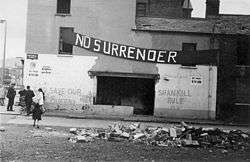
Despite the British government's attempt to do "nothing that would suggest partiality to one section of the community" and the improvement of the relationship between the Army and the local population following the Army assistance with flood relief in August 1970, the Falls Curfew and a situation that was described at the time as "an inflamed sectarian one, which is being deliberately exploited by the IRA and other extremists" meant that relations between the Catholic population and the British Army rapidly deteriorated.[105]
From 1970 through 1972 an explosion of political violence occurred in Northern Ireland. The deadliest attack in the early 70s was the McGurk's Bar bombing by the UVF in 1971.[106] The violence peaked in 1972, when nearly 500 people, just over half of them civilians, lost their lives, the worst year in the entire conflict.[107]
By the end of 1971, 29 barricades were in place in Derry, blocking access to what was known as Free Derry; 16 of these were impassable even to the British Army's one-ton armoured vehicles.[87] Many of the nationalist or republican "no-go areas" were controlled by one of the two factions of the Irish Republican Army—the Provisional IRA and Official IRA. There are several reasons offered for why violence escalated in these years.
Unionists claim the main reason was the formation of the Provisional IRA and Official IRA, particularly the former. These two groups were formed when the IRA split into the 'Provisional' and 'Official' factions. While the older IRA had embraced non-violent civil agitation,[108] the new Provisional IRA was determined to wage "armed struggle" against British rule in Northern Ireland. The new IRA was willing to take on the role of "defenders of the Catholic community",[109] rather than seeking working-class ecumenical unity across both communities.
Nationalists point to a number of events in these years to explain the upsurge in violence. One such incident was the Falls Curfew in July 1970, when 3,000 troops imposed a curfew on the nationalist Lower Falls area of Belfast, firing more than 1,500 rounds of ammunition in gun battles with the Official IRA, and killing four people. Another was the introduction of internment without trial in 1971 (of 350 initial detainees, none were Protestants).[110] Moreover, due to poor intelligence,[111] very few of those interned were actually republican activists at the time, but some internees became increasingly radicalised as a result of their experiences.[55]
Bloody Sunday
A third event, Bloody Sunday, was the shooting dead of thirteen unarmed men by the British Army at a proscribed anti-internment rally in Derry on 30 January 1972 (a fourteenth man died of his injuries some months later) while fifteen other civilians were wounded.[112][113] The march had been organised by the Northern Ireland Civil Rights Association (NICRA). The soldiers involved were members of the 1st Battalion, Parachute Regiment, also known as "1 Para".[114]
This was one of the most prominent events that occurred during the Troubles as it was recorded as the largest number of civilians killed in a single shooting incident.[115] Bloody Sunday greatly increased the hostility of Catholics and Irish nationalists towards the British military and government while significantly elevating tensions. As a result, the Provisional IRA gained more support, especially through rising numbers of recruits in the local areas.[116]
Following the introduction of internment there were numerous gun battles between the British Army and both the Provisional and Official IRA. These included the Battle at Springmartin and the Battle of Lenadoon. Between 1971 and 1975, 1,981 people were interned; 1,874 were Catholic/republican, while 107 were Protestant/loyalist.[117] There were widespread allegations of abuse and even torture of detainees,[118][119] and in 1972, the "five techniques" used by the police and army for interrogation were ruled to be illegal following a British government inquiry.[120]
The Provisional IRA, or "Provos", as they became known, sought to establish themselves as the defender of the nationalist community.[121][122] The Official IRA (OIRA) began its own armed campaign in reaction to the ongoing violence. The Provisional IRA's offensive campaign began in early 1971 when the Army Council sanctioned attacks on the British Army.[123]
In 1972, the Provisional IRA killed approximately 100 members of the security forces, wounded 500 others, and carried out approximately 1,300 bombings,[124] mostly against commercial targets which they considered "the artificial economy".[107][123][125] Their bombing campaign killed many civilians, notably on Bloody Friday on 21 July, when they set off 22 bombs in the centre of Belfast, killing five civilians, two British soldiers, a Royal Ulster Constabulary (RUC) reservist, and an Ulster Defence Association (UDA) member.[126][127][128] Ten days later, nine civilians were killed in a triple car bombing in Claudy.[129] The IRA is accused of committing this bombing but no proof for that accusation is published yet.[130][131]
In 1972 the Official IRA's campaign was largely counter-productive.[132] The Aldershot bombing, an attack on the barracks of the Parachute Regiment in retaliation for Bloody Sunday, killed five female cleaners, a gardener and an army chaplain.[133] The Official IRA killed three soldiers in Derry in April, but Joe McCann was killed by the Parachute Regiment in Belfast during the same month.[132] The Official IRA called off its campaign in May 1972.[134]
British troop concentrations peaked at 20:1000 of the civilian population, the highest ratio found in the history of counterinsurgency warfare, higher than that achieved during the "Malayan Emergency"/"Anti-British National Liberation War", to which the conflict is frequently compared.[135] Operation Motorman, the military operation for the surge, was the biggest military operation in Ireland since the Irish War of Independence.[136] In total, almost 22,000 British forces were involved,[136] In the days before 31 July, about 4,000 extra troops were brought into Northern Ireland.[136]
Despite a temporary ceasefire in 1972 and talks with British officials, the Provisionals were determined to continue their campaign until the achievement of a united Ireland. The UK government in London, believing the Northern Ireland administration incapable of containing the security situation, sought to take over the control of law and order there. As this was unacceptable to the Northern Ireland Government, the British government pushed through emergency legislation (the Northern Ireland (Temporary Provisions) Act 1972) which suspended the unionist-controlled Stormont parliament and government, and introduced "direct rule" from London. Direct rule was initially intended as a short-term measure; the medium-term strategy was to restore self-government to Northern Ireland on a basis that was acceptable to both unionists and nationalists. Agreement proved elusive, however, and the Troubles continued throughout the 1970s, 1980s, and the 1990s within a context of political deadlock. The existence of "no-go areas" in Belfast and Derry was a challenge to the authority of the British government in Northern Ireland, and the British Army demolished the barricades and re-established control over the areas in Operation Motorman on 31 July 1972.[55][125]
Sunningdale Agreement and UWC strike
In June 1973, following the publication of a British White Paper and a referendum in March on the status of Northern Ireland, a new parliamentary body, the Northern Ireland Assembly, was established. Elections to this were held on 28 June. In October 1973, mainstream nationalist and unionist parties, along with the British and Irish governments, negotiated the Sunningdale Agreement, which was intended to produce a political settlement within Northern Ireland, but with a so-called "Irish dimension" involving the Republic. The agreement provided for "power-sharing" – the creation of an executive containing both unionists and nationalists—and a "Council of Ireland" – a body made up of ministers from Northern Ireland and the Republic, designed to encourage cross-border co-operation. The similarities between the Sunningdale Agreement and the Belfast Agreement of 1998 has led some commentators to characterise the latter as "Sunningdale for slow learners".[137] This assertion has been criticised by political scientists, one of whom stated that "... there are ... significant differences between them [Sunningdale and Belfast], both in terms of content and the circumstances surrounding their negotiation, implementation, and operation".[138]
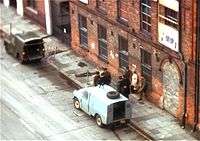
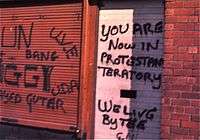
Unionists were split over Sunningdale, which was also opposed by the IRA, whose goal remained nothing short of an end to the existence of Northern Ireland as part of the UK. Many unionists opposed the concept of power-sharing, arguing that it was not feasible to share power with those (nationalists) who sought the destruction of the state. Perhaps more significant, however, was the unionist opposition to the "Irish dimension" and the Council of Ireland, which was perceived as being an all-Ireland parliament-in-waiting. Remarks by a young Social Democratic and Labour Party (SDLP) councillor, Hugh Logue, to an audience at Trinity College Dublin that Sunningdale was the tool "by which the Unionists will be trundled off to a united Ireland" also damaged chances of significant unionist support for the agreement. In January 1974, Brian Faulkner was narrowly deposed as UUP leader and replaced by Harry West, although Faulkner retained his position as Chief Executive in the new government. A UK general election in February 1974 gave the anti-Sunningdale unionists the opportunity to test unionist opinion with the slogan "Dublin is only a Sunningdale away", and the result galvanised their support: they won 11 of the 12 seats, winning 58% of the vote with most of the rest going to nationalists and pro-Sunningdale unionists.[55][125]
Ultimately, however, the Sunningdale Agreement was brought down by mass action on the part of loyalist paramilitaries (primarily the Ulster Defence Association, at that time over 20,000 strong) and workers, who formed the Ulster Workers' Council. They organised a general strike, the Ulster Workers' Council strike. This severely curtailed business in Northern Ireland and cut off essential services such as water and electricity. Nationalists argue that the British Government did not do enough to break this strike and uphold the Sunningdale initiative. There is evidence that the strike was further encouraged by MI5, a part of their campaign to 'disorientate' British prime minister Harold Wilson's government.[139] Faced with such opposition, the pro-Sunningdale unionists resigned from the power-sharing government and the new regime collapsed. Three days into the UWC strike, on 17 May 1974, two UVF teams from the Belfast and Mid-Ulster brigades[69] detonated three no-warning car bombs in Dublin's city centre during the Friday evening rush hour, resulting in 26 deaths and close to 300 injuries. Ninety minutes later, a fourth car bomb exploded in Monaghan, killing seven additional people. Nobody has ever been convicted for these attacks,[55][125] with the bombings being the greatest loss of life in a single day during the Troubles.[115][140]
Proposal of an independent Northern Ireland
Harold Wilson had secretly met with the IRA in 1971 while leader of the opposition; his government in late 1974 and early 1975 again met with the IRA to negotiate a ceasefire. During the meetings the parties discussed the possibility of British withdrawal from an independent Northern Ireland. The failure of Sunningdale led to the serious consideration in London until November 1975 of independence. Had the withdrawal occurred – which Wilson supported but others, including James Callaghan, opposed – the region would have become a separate Dominion of the British Commonwealth.[141]
The British negotiations with an illegal organisation angered the Irish government. It did not know their proceedings but feared that the British were considering abandoning Northern Ireland. Foreign Minister Garret FitzGerald discussed in a memorandum of June 1975 the possibilities of orderly withdrawal and independence, repartition of the island or a collapse of Northern Ireland into civil war and anarchy. The memorandum preferred a negotiated independence as the best of the three "worst case scenarios", but concluded that the Irish government could do little.[141]
The Irish government had already failed to prevent the IRA from burning down the British Embassy in 1972. It believed that it could not enlarge the country's small army of 12,500 men without negative consequences. A civil war in Northern Ireland would cause many deaths there and severe consequences for the Republic, as the public would demand that it intervene to protect nationalists. FitzGerald warned Callaghan that the failure to intervene, despite Ireland's inability to do so, would "threaten democratic government in the Republic", which in turn jeopardised British and European security against Communist and other foreign nations.[141]
The Irish government so dreaded the consequences of an independent Northern Ireland that FitzGerald refused to ask the British not to withdraw—as he feared that openly discussing the issue could permit the British to proceed—and other members of government opposed the Irish Cabinet even discussing what FitzGerald referred to as a "doomsday scenario". He wrote in 2006 that "Neither then nor since has public opinion in Ireland realised how close to disaster our whole island came during the last two years of Harold Wilson's premiership."[141]
Mid-1970s
Merlyn Rees, the Secretary of State for Northern Ireland, lifted the proscription against the UVF in April 1974. In December, one month after the Birmingham pub bombings which killed 21 people, the IRA declared a ceasefire; this would theoretically last throughout most of the following year. The ceasefire notwithstanding, sectarian killings actually escalated in 1975, along with internal feuding between rival paramilitary groups. This made 1975 one of the "bloodiest years of the conflict".[69]
On 31 July 1975 at Buskhill, outside Newry, popular Irish cabaret band the Miami Showband was returning home to Dublin after a gig in Banbridge when it was ambushed by gunmen from the UVF Mid-Ulster Brigade wearing British Army uniforms at a bogus military roadside checkpoint on the main A1 road. Three of the bandmembers, two Catholics and a Protestant, were shot dead, while two of the UVF men were killed when the bomb they had loaded onto the band's minibus detonated prematurely. The following January, eleven Protestant workers were gunned down in Kingsmill, South Armagh after having been ordered off their bus by an armed republican gang, which called itself the South Armagh Republican Action Force. One man survived despite being shot 18 times, leaving ten fatalities. These killings were reportedly in retaliation to a loyalist double shooting attack against the Reavey and O'Dowd families the previous night.[55][107][125]
The violence continued through the rest of the 1970s. This included a series of attacks in Southern England in 1974 and 1975 by Provisional IRA active service unit the Balcombe Street Gang.[142] The British Government reinstated the ban against the UVF in October 1975, making it once more an illegal organisation. The Provisional IRA's December 1974 ceasefire officially ended in January 1976, although it carried out several attacks in 1975.[143][144] It had lost the hope that it had felt in the early 1970s that it could force a rapid British withdrawal from Northern Ireland, and instead developed a strategy known as the "Long War", which involved a less intense but more sustained campaign of violence that could continue indefinitely.[145] The Official IRA ceasefire of 1972, however, became permanent, and the "Official" movement eventually evolved into the Workers' Party, which rejected violence completely. However, a splinter from the "Officials"—the Irish National Liberation Army—continued a campaign of violence in 1974.[125]
Late 1970s
By the late 1970s, war-weariness was visible in both communities. One sign of this was the formation of the Peace People, which won the Nobel Peace Prize in 1976. The Peace People organised large demonstrations calling for an end to paramilitary violence. Their campaign lost momentum, however, after they appealed to the nationalist community to provide information on the IRA to security forces.[146]
The decade ended with a double attack by the IRA against the British. On 27 August 1979, Lord Mountbatten while on holiday in Mullaghmore, County Sligo, was killed by a bomb planted on board his boat. Three other people were also killed: Lady Brabourne, the elderly mother of Mountbatten's son-in-law; and two teenagers, a grandson of Mountbatten and a local boatman.[107] That same day, eighteen British soldiers, mostly members of the Parachute Regiment, were killed by two remote-controlled bombs in the Warrenpoint ambush at Narrow Water Castle, near Warrenpoint, County Down.[69] It was the British Army's largest loss of life in a single incident in Operation Banner.[147]
Successive British Governments, having failed to achieve a political settlement, tried to "normalise" Northern Ireland. Aspects included the removal of internment without trial and the removal of political status for paramilitary prisoners. From 1972 onward, paramilitaries were tried in juryless Diplock courts to avoid intimidation of jurors. On conviction, they were to be treated as ordinary criminals. Resistance to this policy among republican prisoners led to more than 500 of them in the Maze prison initiating the "blanket" and "dirty" protests. Their protests culminated in hunger strikes in 1980 and 1981, aimed at the restoration of political status, as well as other concessions.[55][125]
1980s
In the 1981 Irish hunger strike, ten republican prisoners (seven from the Provisional IRA and three from the INLA) died of starvation. The first hunger striker to die, Bobby Sands, was elected to Parliament on an Anti-H-Block ticket, as was his election agent Owen Carron following Sands' death. The hunger strikes resonated among many nationalists; over 100,000 people[148] attended Sands' funeral mass in West Belfast and thousands attended those of the other hunger strikers. From an Irish republican perspective, the significance of these events was to demonstrate potential for a political and electoral strategy.[149]
In the wake of the hunger strikes, Sinn Féin, which had become the Provisional IRA's political wing,[148][150][151] began to contest elections for the first time in both Northern Ireland (as abstentionists) and in the Republic. In 1986, Sinn Féin recognised the legitimacy of the Irish Dáil, which caused a small group of members to break away and form Republican Sinn Féin.[55]
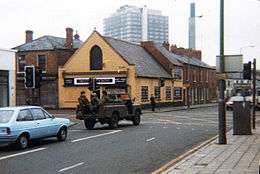
The IRA's "Long War" was boosted by large donations of arms from Libya in the 1980s (see Provisional IRA arms importation) due to Muammar Gaddafi's anger at British Prime Minister, Margaret Thatcher's government for assisting the Reagan government's bombing of Tripoli, which had allegedly killed one of Gaddafi's children. Additionally, it received funding from supporters in the United States and elsewhere throughout the Irish diaspora.
In 1982, the IRA bombed military ceremonies in London's Hyde Park and Regent's Park, killing four soldiers, seven bandsmen and seven horses.[152] The INLA was highly active in the early and mid-1980s. In 1982, it bombed a disco frequented by off-duty British soldiers, killing 11 soldiers and six civilians.[107] One of the IRA's most high-profile actions in this period was the Brighton hotel bombing on 12 October 1984, when it set off a 100-pound bomb in the Grand Brighton Hotel in Brighton, where politicians including Thatcher, were staying for the Conservative Party conference. The bomb, which exploded in the early hours of the morning, killed five people, including Conservative MP Sir Anthony Berry, and injured thirty-four others.[153]
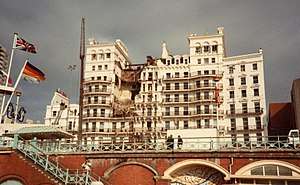
On 28 February 1985 in Newry, nine RUC officers were killed in a mortar attack on the police station.[154][155] It was planned by the IRA's South Armagh Brigade and an IRA unit in Newry. Nine shells were fired from a mark 10 mortar which was bolted onto the back of a hijacked Ford van in Crossmaglen. Eight shells overshot the station; the ninth hit a portable cabin which was being used as a canteen. It was the RUC's largest loss of life during the Troubles.[154] On 8 May 1987, eight IRA members attacked an RUC station in Loughgall, County Armagh, using a bomb and guns.[156] All were killed by the SAS - the most IRA members killed in a single incident in the Troubles.[156] On 8 November 1987, in Enniskillen, County Fermanagh, a Provisional IRA time bomb exploded during a Remembrance Sunday ceremony for UK Commonwealth war casualties. The bomb went off by a cenotaph which was at the heart of the parade. Eleven people (ten civilians, including a pregnant woman, and one serving member of the RUC) were killed and 63 were injured. Former school headmaster Ronnie Hill was seriously injured in the bombing and slipped into a coma two days later, remaining in this condition for more than a decade before his death in December 2000.[157] The IRA eventually apologised for what it claimed had been a mistake and that its target had been the British soldiers parading to the memorial. The unit that carried out the bombing was disbanded. Loyalist paramilitaries responded to the bombing with revenge attacks on Catholics, mostly civilians.[158] Another bomb had been planted at nearby Tullyhommon at a parallel Remembrance Day commemoration but failed to detonate.[125]
In March 1988, three IRA volunteers who were planning a bombing were shot dead by the SAS at a Shell petrol station on Winston Churchill Avenue in Gibraltar, the British Overseas Territory attached to the south of Spain. This became known as Operation Flavius. Their funeral at Milltown Cemetery in Belfast was attacked by Michael Stone, a UDA member who threw grenades as the coffin was lowered and shot at people who chased him. Stone killed three people, including IRA volunteer Kevin Brady. Stone was jailed for life the following year, but was freed 11 years later under the Good Friday Agreement.[159] Two British Army corporals, David Howes and Derek Wood, drove into Brady's funeral in Andersonstown in a civilian car and clothes, with their guns in their car. They were kidnapped, taken away and shot dead by the IRA. This became known as the Corporals killings.[55][125]
In the 1980s, loyalist paramilitary groups, including the Ulster Volunteer Force, the Ulster Defence Association and Ulster Resistance, imported arms and explosives from South Africa.[69] The weapons obtained were divided between the UDA, the UVF and Ulster Resistance, although some of the weaponry (such as rocket-propelled grenades) were hardly used. In 1987, the Irish People's Liberation Organisation (IPLO), a breakaway faction of the INLA, engaged in a bloody feud against the INLA which weakened the INLA's presence in some areas. By 1992, the IPLO was destroyed by the Provisionals for its involvement in drug dealing thus ending the feud.[55]
1990s
Since the late 1980s, while the IRA continued its armed campaign, its political wing Sinn Féin, led since 1983 by Gerry Adams, sought a negotiated end to the conflict, although Adams accurately predicted that this would be a very long process. He predicted the war would last another 20 years. He conducted open talks with John Hume – the SDLP leader – and secret talks with government officials. Loyalists were also engaged in behind-the-scenes talks to end the violence, connecting with the British and Irish governments through Protestant clergy, in particular the Presbyterian minister, Reverend Roy Magee and Anglican Archbishop Robin Eames.
When a French TV crew filmed the IRA at a training camp in Donegal, a representative of the General Headquarters Staff of the IRA was interviewed. He said the IRA would "[E]ventually sap the political will of the British government to remain in Ireland".
Escalation in South Armagh
The IRA's South Armagh Brigade had made the countryside village of Crossmaglen their stronghold since the 1970s. The surrounding villages of Silverbridge, Cullyhanna, Cullaville, Forkhill, Jonesborough and Creggan were also IRA strongholds. In February 1978, a British Army Gazelle helicopter was shot down near Silverbridge, killing Lieutenant Colonel Ian Corden-Lloyd.[160]

In the 1990s, the IRA came up with a new plan to restrict British Army foot patrols near Crossmaglen. They developed two sniper teams to attack British Army and RUC patrols.[161] They usually fired from an improvised armoured car using a .50 BMG calibre M82 sniper rifle. Signs were put up around South Armagh reading "Sniper at Work". The snipers killed a total of nine members of the security forces: seven soldiers and two constables. The last to be killed before the Good Friday Agreement, was a British soldier, bombardier Steven Restorick.
The IRA had developed the capacity to attack helicopters in South Armagh and elsewhere since the 1980s,[162] including the 1990 shootdown of a Gazelle flying over the border between Tyrone and Monaghan; there were no fatalities in that incident.[163]
Another incident involving British helicopters in South Armagh was the Battle of Newry Road in September 1993.[164] Two other helicopters, a British Army Lynx and a Royal Air Force Puma were shot down by improvised mortar fire in 1994. The IRA set up checkpoints in South Armagh during this period, unchallenged by the security forces.[162][165]
Downing Street mortar attack
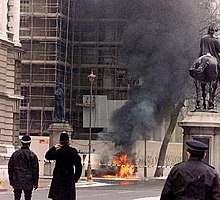
On 7 February 1991, the IRA attempted to assassinate prime minister John Major and his war cabinet by launching a mortar at 10 Downing Street while they were gathered there to discuss the Gulf War. The mortar bombing caused only four injuries, two to police officers, while the prime minister and the entire war cabinet were unharmed.
First ceasefire
After a prolonged period of background political manoeuvring, during which the Baltic Exchange and Bishopsgate bombings occurred in London, both loyalist and republican paramilitary groups declared ceasefires in 1994. The year leading up to the ceasefires was a particularly tense one, marked by atrocities. The UDA and UVF stepped up their attacks. The IRA responded with the Shankill Road bombing in October 1993, which aimed to kill the UDA leadership, but killed eight Protestant civilian shoppers and one low-ranking UDA member, as well as one of the perpetrators, who was killed when the bomb detonated prematurely. The UDA retaliated with mass shootings in nationalist areas such as Greysteel and Castlerock. Eight people were killed at Greysteel and four at Castlerock, all but two of whom were Catholic.[55]
On 16 June 1994, just before the ceasefires, the Irish National Liberation Army killed three UVF members in a gun attack on the Shankill Road. In revenge, three days later, the UVF killed six civilians in a shooting at a pub in Loughinisland, County Down. The IRA, in the remaining month before its ceasefire, killed four senior loyalist paramilitaries, three from the UDA and one from the UVF. On 31 August 1994, the IRA declared a ceasefire. The loyalist paramilitaries, temporarily united in the "Combined Loyalist Military Command", reciprocated six weeks later. Although these ceasefires failed in the short run, they marked an effective end to large-scale political violence, as they paved the way for the final ceasefires.[55][125]
In 1995, the United States appointed George J. Mitchell as the United States Special Envoy for Northern Ireland. Mitchell was recognised as being more than a token envoy and as representing a President (Bill Clinton) with a deep interest in events.[166] The British and Irish governments agreed that Mitchell would chair an international commission on disarmament of paramilitary groups.[167]
Second ceasefire
On 9 February 1996, less than two years after the declaration of the ceasefire, the IRA revoked it with the Docklands bombing in the Canary Wharf area of London, killing two people, injuring 39 others,[168] and causing £85 million in damage to the city's financial centre. Sinn Féin blamed the failure of the ceasefire on the British Government's refusal to begin all-party negotiations until the IRA decommissioned its weapons.[169]
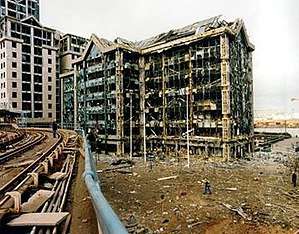
The attack was followed by several more, most notably the 1996 Manchester bombing, which destroyed a large area of the centre of the city on 15 June. It was the largest bomb attack in Britain since World War II. While the attack avoided any fatalities due to a telephone warning and the rapid response of the emergency services, over 200 people were injured in the attack, many of them outside the established cordon. The damage caused by the blast was estimated at £411 million. Lance Bombardier Stephen Restorick, the last British soldier killed during the Troubles, was shot dead at a checkpoint on the Green Rd near Bessbrook on 12 February 1997 by the IRA's South Armagh sniper.[170]
The IRA reinstated their ceasefire in July 1997, as negotiations for the document that became known as the Good Friday Agreement began without Sinn Féin. In September of the same year Sinn Féin signed the Mitchell Principles and were admitted to the talks. The UVF was the first paramilitary grouping to split as a result of their ceasefire, spawning the Loyalist Volunteer Force (LVF) in 1996. In December 1997, the INLA assassinated LVF leader Billy Wright, leading to a series of revenge killings by loyalist groups. A group split from the Provisional IRA and formed the Real IRA (RIRA).[171]
In August 1998, a Real IRA bomb in Omagh killed 29 civilians, the most by a single bomb during the Troubles.[115] This bombing discredited "dissident republicans" and their campaigns in the eyes of many who had previously supported the Provisionals' campaign. They became small groups with little influence, but still capable of violence.[172]
The INLA also declared a ceasefire after the Belfast Agreement of 1998. Since then, most paramilitary violence has been directed at their "own" communities and at other factions within their organisations. The UDA, for example, has feuded with their fellow loyalists the UVF on two occasions since 2000. There have been internal struggles for power between "brigade commanders" and involvement in organised crime.[173]
Provisional IRA members have since been accused or convicted of involvement in the killings of Robert McCartney, Matthew Burns, James Curran, and Andrew Kearney, among others.
Political process
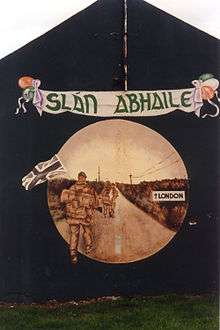
After the ceasefires, talks began between the main political parties in Northern Ireland to establish political agreement. These talks led to the Good Friday Agreement of 1998. This Agreement restored self-government to Northern Ireland on the basis of "power-sharing". In 1999, an executive was formed consisting of the four main parties, including Sinn Féin. Other important changes included the reform of the RUC, renamed as the Police Service of Northern Ireland, which was required to recruit at least a 50% quota of Catholics for ten years, and the removal of Diplock courts under the Justice and Security (Northern Ireland) Act 2007.[174]
A security normalisation process also began as part of the treaty, which comprised the progressive closing of redundant British Army barracks, border observation towers, and the withdrawal of all forces taking part in Operation Banner – including the resident battalions of the Royal Irish Regiment – that would be replaced by an infantry brigade, deployed in ten sites around Northern Ireland but with no operative role in the province.[6]
The power-sharing Executive and Assembly were suspended in 2002, when unionists withdrew following "Stormontgate", a controversy over allegations of an IRA spy ring operating at Stormont. There were ongoing tensions about the Provisional IRA's failure to disarm fully and sufficiently quickly. IRA decommissioning has since been completed (in September 2005) to the satisfaction of most parties.[175]
A feature of Northern Ireland politics since the Agreement has been the eclipse in electoral terms of parties such as the SDLP and Ulster Unionist Party (UUP), by rival parties such as Sinn Féin and the DUP. Similarly, although political violence is greatly reduced, sectarian animosity has not disappeared. Residential areas are more segregated between Catholic nationalists and Protestant unionists than ever.[176] Thus, progress towards restoring the power-sharing institutions was slow and tortuous. On 8 May 2007, devolved government returned to Northern Ireland. DUP leader Ian Paisley and Sinn Féin's Martin McGuinness took office as First Minister and deputy First Minister, respectively.[177]
Collusion between security forces and paramilitaries
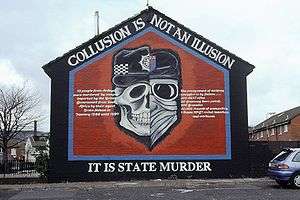
There were many incidents of collusion between the British state security forces (the British Army and RUC) and loyalist paramilitaries. This included soldiers and policemen taking part in loyalist attacks while off-duty, giving weapons and intelligence to loyalists, not taking action against them, and hindering police investigations. The De Silva Report found that, during the 1980s, 85% of the intelligence loyalists used to target people came from the security forces,[178] who in turn also had double agents and informers within loyalist groups who organised attacks on the orders of, or with the knowledge of, their handlers. Of the 210 loyalists arrested by the Stevens Inquiries team, all but three were found to be state agents or informers.[179]
The British Army's locally recruited Ulster Defence Regiment (UDR) was almost wholly Protestant.[180][181] Despite recruits being vetted, some loyalist militants managed to enlist; mainly to obtain weapons, training and information.[182] By 1990, at least 197 UDR soldiers had been convicted of loyalist terrorist offences and other serious crimes, including 19 convicted of murder.[183] This was only a small fraction of those who served in it, but the proportion was higher than the regular British Army, the RUC and the civilian population.[184]
During the 1970s, the Glenanne gang—a secret alliance of loyalist militants, British soldiers and RUC officers—carried out a string of gun and bomb attacks against nationalists in an area of Northern Ireland known as the "murder triangle".[185][186] It also carried out some attacks in the Republic, killing about 120 people in total, mostly uninvolved civilians.[187] The Cassel Report investigated 76 murders attributed to the group and found evidence that soldiers and policemen were involved in 74 of those.[188] One member, RUC officer John Weir, claimed his superiors knew of the collusion but allowed it to continue.[189] The Cassel Report also said some senior officers knew of the crimes but did nothing to prevent, investigate or punish.[188] Attacks attributed to the group include the Dublin and Monaghan bombings (1974), the Miami Showband killings (1975) and the Reavey and O'Dowd killings (1976).[190]
The Stevens Inquiries found that elements of the security forces had used loyalists as "proxies",[191] who, via, double-agents and informers, had helped loyalist groups to kill targeted individuals, usually suspected republicans but civilians were also killed, intentionally and otherwise. The inquiries concluded this had intensified and prolonged the conflict.[192][193] The British Army's Force Research Unit (FRU) was the main agency involved.[191] Brian Nelson, the UDA's chief 'intelligence officer', was a FRU agent.[194] Through Nelson, FRU helped loyalists target people for assassination. FRU commanders say they helped loyalists target only suspected or known republican activists and prevented the killing of civilians.[191] The Inquiries found evidence only two lives were saved and that Nelson/FRU was responsible for at least 30 murders and many other attacks – many on civilians.[192] One victim was solicitor Pat Finucane. Nelson also supervised the shipping of weapons to loyalists in 1988.[194] From 1992 to 1994, loyalists were responsible for more deaths than republicans,[195] partly due to FRU.[196][197] Members of the security forces tried to obstruct the Stevens investigation.[193][198]
A Police Ombudsman report from 2007 revealed that UVF members had been allowed to commit a string of terrorist offences, including murder, while working as informers for RUC Special Branch. It found that Special Branch had given informers immunity by ensuring they were not caught or convicted, and blocking weapons searches.[199] Ombudsman Nuala O'Loan concluded that this had led to "hundreds" of deaths[179] and said senior British Government officials pressured her into halting her investigation.[200] UVF member Robin Jackson has been linked to between 50[201][202] and 100[186] killings in Northern Ireland, although he was never convicted for any.[203] It is alleged by many, including members of the security forces, that Jackson was an RUC agent.[203] The Irish Government's Barron Report alleged that he also "had relationships with British Intelligence".[204]
The Smithwick Tribunal concluded that a member of the Garda Síochána (the Republic of Ireland's police force) colluded with the IRA in the killing of two senior RUC officers in 1989.[205][206][207][208] The two officers were ambushed by the IRA near Jonesborough, County Armagh when returning from a cross-border security conference in Dundalk in the Republic of Ireland.[206]
The Disappeared
During the 1970s and 1980s, republican and loyalist paramilitaries abducted a number of individuals, many alleged to have been informers, who were then killed and secretly buried.[209] Eighteen people — two women and sixteen men — including one British Army officer, were kidnapped and killed during the Troubles. They are referred to informally as "The Disappeared". All but one, Lisa Dorrian, were abducted and killed by republicans. Dorrian is believed to have been abducted by loyalists. The remains of all but four of "The Disappeared" have been recovered and turned over to their families.[210][211][212]
British government security forces, including the Military Reaction Force (MRF), carried out what have been described as "extrajudicial killings" of unarmed civilians.[213][214][215] Their victims were often Catholic or suspected Catholic civilians unaffiliated with any paramilitaries, such as the Whiterock Road shooting of two unarmed Catholic civilians by British soldiers on 15 April 1972, and the Andersonstown shooting of seven unarmed Catholic civilians on 12 May that same year.[216] A member of the MRF stated in 1978 that the Army often attempted false flag sectarian attacks, thus provoking sectarian conflict and "taking the heat off the Army".[217] A former member stated: "[W]e were not there to act like an army unit, we were there to act like a terror group."[218]
Shoot-to-kill allegations
Republicans allege that the security forces operated a shoot-to-kill policy rather than arresting IRA suspects. The security forces denied this and point out that in incidents such as the killing of eight IRA men at Loughgall in 1987, the IRA members who were killed were heavily armed. Others argue that incidents such as the shooting of three unarmed IRA members in Gibraltar by the Special Air Service ten months later confirmed suspicions among republicans, and in the British and Irish media, of a tacit British shoot-to-kill policy of suspected IRA members.[219]
Parades issue
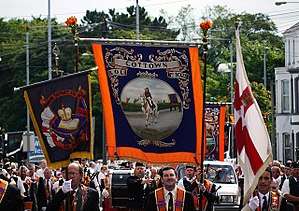
Inter-communal tensions rise and violence often breaks out during the "marching season" when the Protestant Orange Order parades take place across Northern Ireland. The parades are held to commemorate William of Orange's victory in the Battle of the Boyne in 1690, which secured the Protestant Ascendancy and British rule in Ireland. One particular flashpoint which has caused continuous annual strife is the Garvaghy Road area in Portadown, where an Orange parade from Drumcree Church passes through a mainly nationalist estate off the Garvaghy Road. This parade has now been banned indefinitely, following nationalist riots against the parade, and also loyalist counter-riots against its banning.
In 1995, 1996 and 1997, there were several weeks of prolonged rioting throughout Northern Ireland over the impasse at Drumcree. A number of people died in this violence, including a Catholic taxi driver, killed by the Loyalist Volunteer Force, and three (of four) nominally Catholic brothers (from a mixed-religion family) died when their house in Ballymoney was petrol-bombed.[220][221][222]
Social repercussions
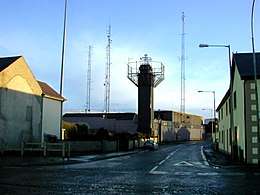
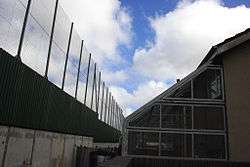
The impact of the Troubles on the ordinary people of Northern Ireland has been compared to that of the Blitz on the people of London.[223] The stress resulting from bomb attacks, street disturbances, security checkpoints, and the constant military presence had the strongest effect on children and young adults.[224] There was also the fear that local paramilitaries instilled in their respective communities with the punishment beatings, "romperings", and the occasional tarring and feathering meted out to individuals for various purported infractions.[225]
In addition to the violence and intimidation, there was chronic unemployment and a severe housing shortage. Many people were rendered homeless as a result of intimidation or having their houses burnt, and urban redevelopment played a role in the social upheaval. Belfast families faced being transferred to new, alien estates when older, decrepit districts such as Sailortown and the Pound Loney were being demolished. According to social worker and author Sarah Nelson, this new social problem of homelessness and disorientation contributed to the breakdown of the normal fabric of society, allowing for paramilitaries to exert a strong influence in certain districts.[225] Vandalism was also a major problem. In the 1970s there were 10,000 vandalised empty houses in Belfast alone. Most of the vandals were aged between eight and thirteen.[226]
According to one historian of the conflict, the stress of the Troubles engendered a breakdown in the previously strict sexual morality of Northern Ireland, resulting in a "confused hedonism" in respect of personal life.[227] In Derry, illegitimate births and alcoholism increased for women and the divorce rate rose.[228] Teenage alcoholism was also a problem, partly as a result of the drinking clubs established in both loyalist and republican areas. In many cases, there was little parental supervision of children in some of the poorer districts.[229] The Department of Health has looked at a report written in 2007 by Mike Tomlinson of Queen's University, which asserted that the legacy of the Troubles has played a substantial role in the current rate of suicide in Northern Ireland.[230]
Casualties
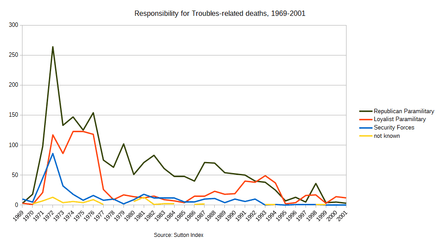
According to the Conflict Archive on the Internet (CAIN), 3,532 people were killed as a result of the conflict between 1969 and 2001.[231] Of these, 3,489 were killed up to 1998.[231] According to the book Lost Lives (2006 edition), 3,720 people were killed as a result of the conflict, from 1966 to 2006. Of these, 3,635 were killed up to 1998.[232] There are reports that 257 of the victims were children under the age of seventeen, representing 7.2% of all the total during this period.[233] Other reports state that a total of 274 children under the age of eighteen were killed during the conflict.[234]
In The Politics of Antagonism: Understanding Northern Ireland, Brendan O'Leary and John McGarry point out that "nearly two per cent of the population of Northern Ireland have been killed or injured through political violence [...] If the equivalent ratio of victims to population had been produced in Great Britain in the same period some 100,000 people would have died, and if a similar level of political violence had taken place, the number of fatalities in the USA would have been over 500,000".[235] Using this relative comparison to the US, analyst John M. Gates suggests that whatever one calls the conflict, it was "certainly not" a "low intensity conflict".[236]
In 2010 it was estimated that 107,000 people in Northern Ireland suffered some physical injury as a result of the conflict. On the basis of data gathered by the Northern Ireland Statistics and Research Agency, the Victims Commission estimated that the conflict resulted in 500,000 'victims' in Northern Ireland alone. It defines 'victims' are those who are directly affected by 'bereavement', 'physical injury' or 'trauma' as a result of the conflict.[237]
Responsibility
Approximately 60% of the dead were killed by republicans, 30% by loyalists and 10% by British security forces.
| Responsible party | No. |
|---|---|
| Republican paramilitary groups | 2057 |
| Loyalist paramilitary groups | 1027 |
| British security forces | 363 |
| Persons unknown | 80 |
| Irish security forces | 5 |
| Total | 3532 |
According to Malcolm Sutton's Index of Deaths from the Conflict in Ireland:[238]
Of those killed by British security forces:
- 186 (~51.2%) were civilians
- 146 (~40.2%) were members of republican paramilitaries
- 18 (~5.0%) were members of loyalist paramilitaries
- 13 (~3.6%) were fellow members of the British security forces
Of those killed by republican paramilitaries:
- 1080 (~52.5%) were members/former members of the British security forces
- 721 (~35.1%) were civilians
- 188 (~9.2%) were members of republican paramilitaries
- 57 (~2.8%) were members of loyalist paramilitaries
- 11 (~0.5%) were members of the Irish security forces
Of those killed by loyalist paramilitaries:
- 878 (~85.5%) were civilians
- 94 (~9.2%) were members of loyalist paramilitaries
- 41 (~4.0%) were members of republican paramilitaries
- 14 (~1.4%) were members of the British security forces
Status
Approximately 52% of the dead were civilians, 32% were members or former members of the British security forces, 11% were members of republican paramilitaries, and 5% were members of loyalist paramilitaries.[37] About 60% of the civilian casualties were Catholics, 30% of the civilians were Protestants, and the rest were from outside Northern Ireland.[239]
Of the civilian casualties, 48% were killed by loyalists, 39% were killed by republicans, and 10% were killed by the British security forces.[238] Most of the Catholic civilians were killed by loyalists, and most of the Protestant civilians were killed by republicans.[240]
It has been the subject of dispute whether some individuals were members of paramilitary organisations. Several casualties that were listed as civilians were later claimed by the IRA as their members.[241] One Ulster Defence Association (UDA) and three Ulster Volunteer Force (UVF) members killed during the conflict were also Ulster Defence Regiment (UDR) soldiers at the time of their deaths.[242] At least one civilian victim was an off-duty member of the Territorial Army.[243]
| Status | No. |
|---|---|
| Civilians (inc. Civilian political activists) | 1841 |
| British security force personnel (serving and former members) | 1114 |
| British Army (inc. UDR, RIR and TA) | 757 |
| Royal Ulster Constabulary | 319 |
| Northern Ireland Prison Service | 26 |
| English police forces | 6 |
| Royal Air Force | 4 |
| Royal Navy | 2 |
| Irish security force personnel | 11 |
| Garda Síochána | 9 |
| Irish Army | 1 |
| Irish Prison Service | 1 |
| Members of Republican paramilitaries | 396 |
| Members of Loyalist paramilitaries | 170 |
Location
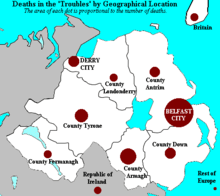
Most killings took place within Northern Ireland, especially in Belfast and County Armagh. Most of the killings in Belfast took place in the west and north of the city. Dublin, London and Birmingham were also affected, albeit to a lesser degree than Northern Ireland itself. Occasionally, the IRA attempted or carried out attacks on British targets in Gibraltar, Germany, Belgium and the Netherlands.[244][245]
| Location | No. |
|---|---|
| Belfast | 1,541 |
| West Belfast | 623 |
| North Belfast | 577 |
| South Belfast | 213 |
| East Belfast | 128 |
| County Armagh | 477 |
| County Tyrone | 340 |
| County Down | 243 |
| Derry City | 227 |
| County Antrim | 209 |
| County Londonderry | 123 |
| County Fermanagh | 112 |
| Republic of Ireland | 116 |
| England | 125 |
| Continental Europe | 18 |
Chronological listing
| Year | No. |
|---|---|
| 2001 | 16 |
| 2000 | 19 |
| 1999 | 8 |
| 1998 | 55 |
| 1997 | 22 |
| 1996 | 18 |
| 1995 | 9 |
| 1994 | 64 |
| 1993 | 88 |
| 1992 | 88 |
| 1991 | 97 |
| 1990 | 81 |
| 1989 | 76 |
| 1988 | 104 |
| 1987 | 98 |
| 1986 | 61 |
| 1985 | 57 |
| 1984 | 69 |
| 1983 | 84 |
| 1982 | 111 |
| 1981 | 114 |
| 1980 | 80 |
| 1979 | 121 |
| 1978 | 82 |
| 1977 | 110 |
| 1976 | 297 |
| 1975 | 260 |
| 1974 | 294 |
| 1973 | 255 |
| 1972 | 480 |
| 1971 | 171 |
| 1970 | 26 |
| 1969 | 16 |
Additional statistics
| Incident | No. |
|---|---|
| Injury | 47,541 |
| Shooting incident | 36,923 |
| Armed robbery | 22,539 |
| People charged with paramilitary offences | 19,605 |
| Bombing and attempted bombing | 16,209 |
| Arson | 2,225 |
See also
- Directory of the Northern Ireland Troubles
- List of Irish uprisings
- Timeline of the Northern Ireland Troubles and peace process
- Timeline of Provisional Irish Republican Army actions
- Timeline of Irish National Liberation Army actions
- Timeline of Ulster Volunteer Force actions
- Timeline of Ulster Defence Association actions
- Timeline of Ulster Defence Regiment operations
- Timeline of Real Irish Republican Army actions
- Chronology of Continuity Irish Republican Army actions
- List of bombings during the Northern Ireland Troubles
- List of Irish police officers killed in the line of duty
- Segregation in Northern Ireland
In popular culture
- The Troubles in popular culture
- Category:Works about The Troubles (Northern Ireland)
- List of books about the Troubles
- Murals in Northern Ireland
Similar wars
- Basque conflict – Basque Country, Spain
- Corsican conflict – Corsica, France and Sardinia, Italy
- War In Donbass – Donetsk and Lugansk People's Republics, Ukraine
Notes
- The "troubles" was used to describe the 17th-century Wars of the Three Kingdoms by all three national parliaments. For example, after the Restoration in 1660 the English Act of free and general pardon, indemnity and oblivion starts with "The King's most excellent Majesty, taking into his gracious and serious consideration the long and great troubles..."; as does the similar act in Scotland: "The king's most excellent majesty, considering that by the late troubles diverse of his subjects..." (Scottish Parliament 1662); and by the Irish Parliament in the Act of Explanation (1665) "our royal father of blessed memory had been forced, during the late troubles, to make with the Irish subjects of that our kingdom" (Irish Parliament 1665, § 2).
References
- Melaugh, Martin (3 February 2006). "Frequently Asked Questions – The Northern Ireland Conflict". Conflict Archive on the Internet. Ulster University. Retrieved 18 May 2017.
- Aughey, Arthur (2005). The Politics of Northern Ireland: Beyond the Belfast Agreement. London New York: Routledge. p. 7. ISBN 978-0-415-32788-6. OCLC 55962335.
- Holland, Jack (August 1999). Hope Against History: The Course of Conflict in Northern Ireland. Henry Holt and Company. p. 221. ISBN 9780805060874.
The troubles were over, but the killing continued. Some of the heirs to Ireland's violent traditions refused to give up their inheritance.
- Gillespie, Gordon (2008). Historical Dictionary of the Northern Ireland Conflict. Scarecrow Press. p. 250. ISBN 978-0-8108-5583-0.
- Taylor, Peter (1997). "Chapter 21: Stalemate". Behind the Mask: The IRA and Sinn Féin. New York: TV Books. pp. 246–61. ISBN 978-1-57500-061-9. OCLC 38012191.
- Ministry of Defence Annual Report and Accounts 2006–2007 (PDF) (Report). Ministry of Defence. 23 July 2007. HC 697. Retrieved 24 February 2016.
- Sutton, Malcolm. "Sutton Index of Deaths". Conflict Archive on the Internet. Retrieved 18 May 2017.
- Eamonn Mallie and Patrick Bishop, The Provisional IRA, page 12.
- Melaugh, Martin. "CAIN: Abstracts of Organisations – 'U'". Conflict Archive on the Internet. Ulster University.
- Sutton, Malcolm. "Sutton Index of Deaths – Status Summary". Conflict Archive on the Internet.
- Melaugh, Mertin; Lynn, Brendan; McKenna, F. "Northern Ireland Society – Security and Defence". Conflict Archive on the Internet. Ulster University.
- "History – The Troubles – Violence". BBC. Retrieved 26 May 2013.
- Mitchell, Claire (2013). Religion, Identity and Politics in Northern Ireland. Ashgate Publishing. p. 5.
The most popular school of thought on religion is encapsulated in McGarry and O'Leary's Explaining Northern Ireland (1995), and it is echoed by Coulter (1999) and Clayton (1998). The central argument is that religion is an ethnic marker, but that it is not generally politically relevant in and of itself. Instead, ethnonationalism lies at the root of the conflict. Hayes and McAllister (1999a) point out that this represents something of an academic consensus.
- John McGarry & Brendan O'Leary (15 June 1995). Explaining Northern Ireland. Wiley-Blackwell. p. 18. ISBN 978-0-631-18349-5.
- Dermot Keogh, ed. (28 January 1994). Northern Ireland and the Politics of Reconciliation. Cambridge University Press. pp. 55–59. ISBN 978-0-521-45933-4.
- John Coakley. "Ethnic Conflict and the Two-State Solution: The Irish Experience of Partition". Archived from the original (PDF) on 29 February 2012. Retrieved 15 February 2009.
...these attitudes are not rooted particularly in religious belief, but rather in underlying ethnonational identity patterns.
- Melaugh, Martin; Lynn, Brendan. "Glossary of Terms on Northern Ireland Conflict". Conflict Archive on the Internet. Ulster University.
The term 'the Troubles' is a euphemism used by people in Ireland for the present conflict. The term has been used before to describe other periods of Irish history. On the CAIN web site the terms 'Northern Ireland conflict' and 'the Troubles', are used interchangeably.
- McEvoy, Joanne (2008). The politics of Northern Ireland. Edinburgh: Edinburgh University Press. p. 1. ISBN 978-0-7486-2501-7. OCLC 232570935.
The Northern Ireland conflict, known locally as 'the Troubles', endured for three decades and claimed the lives of more than 3,500 people.
- McKittrick, David; McVea, David (2001). Making Sense of the Troubles: A History of the Northern Ireland Conflict (Rev ed.). Penguin Books. ISBN 9780141003054.
- Edwards, Aaron; McGrattan, Cillian (2012). The Northern Ireland Conflict: A Beginner's Guide. Oneworld Publications. ISBN 9781780741710.
- Lesley-Dixon, Kenneth (2018). Northern Ireland: The Troubles: From The Provos to The Det. Pen and Sword Books. p. 13.
- Schaeffer, Robert (1999). Severed States: Dilemmas of Democracy in a Divided World. Rowman & Littlefield. p. 152.
- Rainey, Mark (12 November 2016). "Special Branch officer's insider view of Northern Ireland's 'secret war'". The News Letter. Johnston Publishing (NI).
- Taylor, Peter (26 September 2014). "Who Won The War? Revisiting NI on 20th anniversary of ceasefires". BBC News. Retrieved 26 September 2014.
- "Troubles 'not war' motion passed". BBC. 18 February 2008. Retrieved 3 March 2015.
- Hennessey, Thomas (2001). The Northern Ireland peace process: ending the troubles?. Palgrave Macmillan. pp. 48. ISBN 978-0312239497.
- Gillespie, Gordon (November 2007). Historical Dictionary of the Northern Ireland Conflict. Scarecrow Press. p. 250. ISBN 978-0810855830.
- Elliott, Marianne (2007). The Long Road to Peace in Northern Ireland: Peace Lectures from the Institute of Irish Studies at Liverpool University (2 ed.). Liverpool University Press. pp. 2, 188. ISBN 978-1-84631-065-2.
- Goodspeed, Michael (2002). When Reason Fails: Portraits of Armies at War : America, Britain, Israel, and the Future. Greenwood Publishing Group. pp. 44, 61. ISBN 0-275-97378-6.
- English, Richard (1 January 2005). Armed Struggle: The History of the IRA. Oxford University Press. ISBN 9780195177534.
- Storey, Michael L. (2004). Representing the Troubles in Irish Short Fiction. The Catholic University of America Press. p. 149. ISBN 978-0813213668.
- Richard Jenkins (1997). Rethinking Ethnicity: Arguments and Explorations. SAGE Publications. p. 120.
It should, I think, be apparent that the Northern Irish conflict is not a religious conflict... Although religion has a place—and indeed an important one—in the repertoire of conflict in Northern Ireland, the majority of participants see the situation as primarily concerned with matters of politics and nationalism, not religion. And there is no reason to disagree with them.
- Richard English. The State: Historical and Political Dimensions, Charles Townshend, 1998, Routledge, p. 96; ISBN 0-41515-477-4.
- Dominic Bryan. Orange Parades: The Politics of Ritual, Tradition and Control, Pluto Press (2000), p. 94; ISBN 0-74531-413-9.
- "The Troubles: How 1969 violence led to Army's longest campaign". BBC News, 14 August 2019.
- Operation Banner, alphahistory.com. Retrieved 18 June 2016.
- "Sutton Index of Deaths: Summary of Organisation responsible". Conflict Archive on the Internet (CAIN). Ulster University. Retrieved 24 February 2016.
- Editor, Gerry Moriarty Northern (5 August 2019). "Northern Ireland: Eighty-one 'punishment attacks' in past year". The Irish Times. Retrieved 28 November 2019.CS1 maint: extra text: authors list (link)
- "Draft List of Deaths Related to the Conflict (2003–present)". Retrieved 31 July 2008.
- Peter Cottrell (2006). The Anglo-Irish War: The Troubles of 1913–1922. Osprey Publishing. p. 7. ISBN 978-1846030239. Retrieved 23 January 2015.
- Michael L. Storey (2004). Representing the Troubles in Irish Short Fiction. CUA Press. p. 2. ISBN 978-0813213668. Retrieved 23 January 2015.
- Peter Rose (2001), How the Troubles Came to Northern Ireland. p. 94. ISBN 9780333753460.
- Anisseh Van Engeland & Rachael M. Rudolph. From Terrorism to Politics (2008), Aldershot, England; Burlington, VT: Ashgate. page 59. ISBN 9780754649908.
- Ryan Hackney and Amy Blackwell Hackney. The Everything Irish History & Heritage Book (2004). p. 200
- General Sir Michael Jackson. "Operation Banner: An analysis of military operations in Northern Ireland" (PDF). p. Chapter 1 Introduction, pg 1–1. Archived from the original (PDF) on 8 April 2008. Retrieved 23 July 2014.
- "UK military operations in Northern Ireland 1969–2006 aka Operation Banner". Retrieved 4 October 2016.
- The Ballast report Archived 25 June 2008 at the Wayback Machine : "the Police Ombudsman has concluded that this was collusion by certain police officers with identified UVF informants".
- Parliamentary debate: "The British government agree that it is for the people of the island of Ireland alone, by agreement between the two parts respectively, to exercise their right of self-determination on the basis of consent, freely and concurrently given, North and South, to bring about a united Ireland, if that is their wish."
- Laurel Holliday. Children of the Troubles. 1998, pp. 341–42.
- Northern Ireland still divided by peace walls 20 years after conflict
- "Out of trouble: How diplomacy brought peace to Northern Ireland". CNN. 17 March 2008. Retrieved 2 November 2008.
- Frank Wright. Ulster: Two Lands, One Soil, 1996, p. 17.
- "Profile: The Orange Order". BBC News. 4 July 2001. Retrieved 2 November 2008.
- English, Richard (2006). Irish Freedom: The History of Nationalism in Ireland. Pan Books. pp. 200–231. ISBN 978-0-330-42759-3.
- Coogan, Tim Pat (2002). The Troubles: Ireland's Ordeal and the Search for Peace. Palgrave Macmillan.
- Peter Taylor (1989). Families at War. BBC. p. 10. ISBN 978-0-563-20787-0.
- English, Richard (2003). Armed Struggle: The History of the IRA. Oxford University Press. pp. 39–40. ISBN 978-0-19-517753-4. Retrieved 3 October 2016.
- "CRESC Working Paper Series : Working Paper No. 122" (PDF). Cresc.ac.uk. Archived from the original (PDF) on 1 January 2017. Retrieved 3 October 2016.
- Meehan, Niall (1 January 1970). "Facts and Figures of the Belfast Pogroms G.B. Kenna 1922 | Niall Meehan". Academia.edu. Retrieved 3 October 2016.
- "History Ireland". History Ireland. 4 March 2013. Retrieved 3 October 2016.
- Peter Hart (2003). The I.R.A. at war, 1916–1923. Oxford University Press. pp. 247, 251. ISBN 978-0-19-925258-9.
- Laura K. Dohonue. "Regulating Northern Ireland: The Special Powers Acts, 1922–1972", The Historical Journal (1998), vol 41, no. 4.
- "Revisiting the Northern Ireland Civil Rights Movement: 1968-69 – The Irish Story".
- "Beginning of the Troubles, CAIN". Cain.ulst.ac.uk.
- Chronology of Key Events in Irish History: 1800 to 1967, cain.ulst.ac.uk. Retrieved 12 June 2013.
- Loyalists, pp. 37–40.
- Andrew Boyd. Holy War in Belfast. "Chapter 11: The Tricolour Riots". Anvil Books, 1969; reproduced here.
- Hugh Jordan. Milestones in Murder: Defining moments in Ulster's terror war. Random House, 2011. Chapter 3.
- Peter Taylor. Loyalists (1990). London: Bloomsbury Publishing Plc. pp. 41–44, 125, 143, 163, 188–90
- "We Shall Overcome ... The History of the Struggle for Civil Rights in Northern Ireland 1968–1978". cain.ulst.ac.uk. Retrieved 17 March 2015.
- Northern Ireland: The Plain Truth (second edition), Campaign for Social Justice in Northern Ireland, 15 June 1969. Retrieved 12 June 2013.
- Jonathan Tonge (2002). Northern Ireland: Conflict and Change. Longman. pp. 37–38. ISBN 978-0-582-42400-5.
- Various (2006). Politics UK. Longman. p. 770. ISBN 978-1-4058-2411-8.
- Joint Committee on Human Rights, Parliament of the United Kingdom (2005). Counter-Terrorism Policy And Human Rights: Terrorism Bill and related matters: Oral and Written Evidence. Counter-Terrorism Policy And Human Rights: Terrorism Bill and related matters. 2. The Stationery Office. p. 110. ISBN 978-0-10-400766-2.
- English (2003), pp. 91, 94, 98
- Lord Cameron, Disturbances in Northern Ireland: Report of the Commission appointed by the Governor of Northern Ireland (Belfast, 1969). Chapter 16. Quote: "While there is evidence that members of the I.R.A. are active in the organisation, there is no sign that they are in any sense dominant or in a position to control or direct policy of the Civil Rights Association."
- M. L. R. Smith (2002). Fighting for Ireland?: The Military Strategy of the Irish Republican Movement. Routledge. p. 81.
Republicans were instrumental in setting up NICRA itself, though they did not control the Association and remained a minority faction within it.
- Bob Purdie. "Chapter 4: The Northern Ireland Civil Rights Association". Politics in the Streets: The origins of the civil rights movement in Northern Ireland. Blackstaff Press.
There is also clear evidence that the republicans were not actually in control of NICRA in the period up to and including the 5 October march.
- Chronology of the Conflict: 1968, cain.ulst.ac.uk. Retrieved 12 June 2013.
- "Sixteen of us in one small house" (Audio) (Interview). Interviewed by Proinsias Ó Conluain. RTÉ Archives. 27 August 1969. Retrieved 22 July 2013.
- "Caledon Housing Protest". Campaign for Civil Rights. Archived from the original on 28 August 2013. Retrieved 23 July 2013.
- "Submission to the Independent Commission into Policing". Serve.com. Retrieved 2 November 2008.
- Martin Melaugh. "The Derry March: Main events of the day". Conflict Archive on the Internet (CAIN). Ulster University. Retrieved 16 February 2008.
- Rex Cathcart (1984). The Most Contrary Region. The Blackstaff Press. p. 208. ISBN 978-0856403231.
- Bowes Egan and Vincent McCormack. Burntollet. L.R.S. Publishers, 1969; reproduced on CAIN. Retrieved 12 June 2013.
- Taylor, Peter (1997). Provos The IRA & Sinn Féin. Bloomsbury Publishing. p. 43. ISBN 0-7475-3818-2.
- Taylor, Peter (2001). Brits: The War Against the IRA. Bloomsbury Publishing. p. 82. ISBN 978-0-7475-5806-4.
- "Chronology of the Conflict: 1969". cain.ulst.ac.uk. Retrieved 12 June 2013.
- Jim Cusack & Henry McDonald. UVF. Poolbeg, 1997. p. 28
- Peter Taylor (1999). Loyalists. Bloomsbury Publishing. pp. 59–60. ISBN 978-0-7475-4519-4.
- Police Ombudsman statement on Devenny investigation, cain.ulst.ac.uk. Retrieved 4 October 2001.
- Russell Stetler. Extract from The Battle of Bogside (1970), cain.ulst.ac.uk. Retrieved 17 March 2015.
- The Troubles: Ireland's Ordeal and the Search for Peace, page 89
- John Ranelagh (1994). A Short History of Ireland (2, illustrated, revised ed.). Cambridge University Press. p. 272. ISBN 978-0-521-46944-9.
- Downey, James (2 January 2001). "Army on Armageddon alert". Irish Independent. Retrieved 7 December 2015.
- Michael McKernan (2005). Northern Ireland Yearbook 2005. Stationery Office. p. 17. ISBN 978-0-9546284-2-0.
- McKittrick, David (2004). Lost Lives: The Stories of the Men, Women and Children Who Died as a Result of the Northern Ireland Troubles. Mainstream Publishing. p. 31. ISBN 978-1840185041.
- McKittrick, David (2004). Lost Lives: The Stories of the Men, Women and Children Who Died as a Result of the Northern Ireland Troubles. Mainstream Publishing. p. 41. ISBN 978-1840185041.
- The Troubles: Ireland's Ordeal and the Search for Peace, page 91
- Rudolph Jr., Joseph R (2013). From Mediation to Nation-Building: Third Parties and the Management of Communal Conflict. Lexington Books. p. 310. ISBN 978-0739176948.
- "Conclusions of a meeting of the Joint Security Committee held on Tuesday, 9th September, 1969, at Stormont Castle [PRONI Public Records HA/32/3/2]" (PDF). CAIN. Retrieved 13 April 2019.
- McCluskey, Conn (1969). Up off their knees: a commentary on the civil rights movement in Northern Ireland. p. 173. ISBN 0951483706. Retrieved 13 April 2019.
- "Interfaces". Peacewall Archive. Retrieved 13 April 2019.
- David McKittrick. Lost Lives: The Stories of the Men, Women and Children who Died as a Result of the Northern Ireland Troubles. Random House, 2001. p. 42
- English, Richard (9 December 2004). Armed Struggle: The History of the IRA. Oxford University Press. p. 136. ISBN 9780195177534.
- "McGurk's bar bombing - A dark night in the darkest times". 21 February 2011 – via www.bbc.co.uk.
- Sutton Index of Deaths, cain.ulst.ac.uk. Retrieved 3 March 2015.
- Patrick Bishop & Eamonn Mallie (1987). The Provisional IRA. Corgi Books. pp. 52–54. ISBN 978-0-552-13337-1.
- English (2003), pp. 134–35
- R.K. Walker (2006). The Hunger Strikes. Lagan Books. p. 27. ISBN 978-1-904684-18-3.
- David Bonner (2007). Executive Measures, Terrorism and National Security: Have the Rules of the Game Changed?. Ashgate. p. 89. ISBN 978-0-7546-4756-0.
- Melaugh, Dr Martin. "CAIN: Events: 'Bloody Sunday' – Names of Dead and Injured". Conflict Archive on the Internet. Retrieved 9 May 2017.
- Walsh, Dermot (2000). Bloody Sunday and the Rule of Law in Northern Ireland. Gill & Macmillan. p. 88. ISBN 978-0717130856. Retrieved 5 December 2015.
- Melaugh, Dr Martin. "CAIN: [Widgery Report] Report of the Tribunal appointed to inquire into events on Sunday 30 January 1972". Conflict Archive on the Internet. Retrieved 9 May 2017.
- Melaugh, Dr Martin. "CAIN: Violence: List of Significant Violent Incidents". Conflict Archive on the Internet. Retrieved 9 May 2017.
- Those Are Real Bullets, Aren't They?. London: Fourth Estate: Peter Pringle and Phillip Jacobson. 2000. p. 293. ISBN 978-1-84115-316-2.
- "Internment – Summary of Main Events". Cain.ulst.ac.uk. Retrieved 3 March 2015.
- Oren Gross & Fionnuala Ní Aoláin. Law in Times of Crisis: Emergency Powers in Theory and Practice, p. 188; ISBN 978-0521833516.
- Anthony Stuart Mathews. Freedom, state security and the rule of law: Dilemmas of the apartheid society, p. 246; ISBN 978-0-702-11812-8.
- Mireille Delmas-Marty. The European Convention for the Protection of Human Rights: International Protection Versus National Restrictions, pp. 261–62; ISBN 978-0-792-31283-3.
- Ed Moloney. A Secret History of the IRA, pp. 89–90; ISBN 0-141-01041-X.
- Peter Taylor. Provos: The IRA and Sinn Féin, pp. 75–79; ISBN 9780-7475-3818-9.
- English (2003), p. 137
- Brendan O'Brien (1995). The Long War – The IRA and Sinn Féin. O'Brien Press, Ltd. p. 119. ISBN 978-0-86278-425-6.
- J. Bowyer Bell (1997). The Secret Army: The IRA. Transaction Publishers. p. 381. ISBN 978-1-56000-901-6.
- Bloody Friday: What happened
- McKittrick, David (2004). Lost Lives: The Stories of the Men, Women and Children Who Died as a Result of the Northern Ireland Troubles. Mainstream Publishing. p. 237. ISBN 978-1840185041.
- Claudy bomb memorial
- New investigation into Claudy bombing
- IRA bomb in Claudy was indefensible, says Martin McGuinness
- Saunders, Andrew (2012). Inside The IRA: Dissident Republicans And The War For Legitimacy. Edinburgh University Press. p. 70. ISBN 978-0-7486-4696-8.
- Moloney, Ed (2002). A Secret History of the IRA. Penguin Books. p. 111. ISBN 978-0-14-101041-0.
- "1972: Official IRA declares ceasefire". BBC News. 30 May 1981.
- Moore, Riley M. (1 October 2013). "Counterinsurgency force ratio: strategic utility or nominal necessity". Small Wars & Insurgencies. 24 (5): 857–878. doi:10.1080/09592318.2013.866423.
- Melaugh, Dr Martin. "CAIN: Chronology of the Conflict 1972". Conflict Archive on the Internet.
- Daltún Ó Ceallaigh. "Along The road to Irish unity?", Irish Democrat, April/May 2002.
- Rick Wilford. Context and Content: Sunningdale and Belfast Compared, 2001, Oxford University Press, pg. 1
- Keeping Secrets, London Review of Books, April 1987.
- "UK urged to Release Dublin and Monaghan Bombing Files". The Irish Times. 17 May 2017. Retrieved 18 September 2019.
- Garret FitzGerald (2006). "The 1974–5 Threat of a British Withdrawal from Northern Ireland" (PDF). Irish Studies in International Affairs. 17: 141–150. doi:10.3318/ISIA.2006.17.1.141. Archived from the original (PDF) on 26 September 2007.
- Mullin, John (10 April 1999). "Balcombe Street Gang to be freed". The Guardian. Retrieved 24 April 2020.
- IRA Truce: 9 February 1975 to 23 January 1976 - A Chronology of Main Events
- Peter Taylor. Provos: The IRA and Sinn Féin, p. 197; ISBN 9780-7475-3818-9.
- Ed Moloney. A Secret History of the IRA, pp. 149–150; ISBN 0-141-01041-X.
- Brian Dooley. Black and Green: Fight for Civil Rights in Northern Ireland and Black America, pg 129; ISBN 978-0-74531-295-8.
- 1979: Soldiers die in Warrenpoint
- "The Hunger Strike of 1981 – A Chronology of Main Events". CAIN. Retrieved 26 May 2007.
- English (2003), p. 200
- Peter Taylor. Behind the Mask: The IRA and Sinn Féin, TV books, Inc., New York, 1997; ISBN 1-57500-061-X.
- Kevin Toolis. Rebel Hearts: Journeys Within the IRA's Soul, Picador 2000; ISBN 978-0-330-34648-1.
- "1982: IRA bombs cause carnage in London". 20 July 1982 – via news.bbc.co.uk.
- "On This Day: 12 October 1984". BBC News. 12 October 2000. Retrieved 26 May 2013.
- RUC and IRA chiefs' lives feature in national biography
- CAIN
- IRA men shot dead at Loughgall had been under surveillance for weeks
- "NORTHERN IRELAND | IRA bomb victim buried". BBC News. 30 December 2000. Retrieved 3 October 2016.
- McKittrick, David. Lost Lives: The stories of the men, women and children who died as a result of the Northern Ireland Troubles. Random House, 2001. pp.1094–1099
- On this day: Loyalist killer Michael Stone freed from Maze, BBC
- "A Chronology of the Conflict, 1978". Conflict Archive on the Internet (CAIN). Retrieved 3 November 2014.
- General Sir Michael Jackson. Operation Banner: An Analysis of Military Operations in Northern Ireland (2006), MoD, Army Code 71842. Chapter 2, p. 16, item 247.
- Toby Harnden (2000). Bandit Country:The IRA and South Armagh. London, UK: Coronet Books. pp. 358–9. ISBN 978-0-340-71737-0.
- "Soldiers hurt in IRA attack on helicopter". Glasgow Herald. 12 February 1990. Retrieved 17 March 2015.
- Michael Ashcroft (2012). Heroes of the Skies. Hachette UK. pp. 355–56. ISBN 978-0755363919.
- Department of the Official Report (Hansard), House of Commons, Westminster (8 June 1993). "House of Commons Hansard Debates for 8 Jun 1993". Parliament of the United Kingdom. Retrieved 3 October 2016.CS1 maint: multiple names: authors list (link)
- "US policy and Northern Ireland". BBC News. 8 April 2003.
- "A Break in the Irish Impasse". The New York Times. 30 November 1995.
- "BBC ON THIS DAY 1996: Docklands bomb ends IRA ceasefire". BBC News. 10 February 1996. Retrieved 3 October 2016.
- "IRA claims responsibility for London bombing". CNN. Retrieved 25 May 2010.
- Bingham, John (9 March 2009). "Northern Ireland shootings: The last soldier murdered". The Telegraph. Retrieved 9 May 2017.
- "Explainer: Real IRA and Continuity IRA". The Guardian. London. 10 March 2009.
- "HC 502 Cover" (PDF). Archived from the original (PDF) on 26 July 2011. Retrieved 2 November 2008.
- Henry McDonald (30 July 2006). "New feud rips apart the UDA". The Guardian. London, UK.
- Northern Ireland becoming a more normalised society Archived 8 January 2007 at the Wayback Machine – Northern Ireland Office, 27 November 2006.
- "IRA 'has destroyed all its arms'". BBC. 26 September 2005. Retrieved 6 April 2007.
- Margaret Scanlan. Culture and Customs of Ireland, Greenwood Publishing Group, pg. 51, 2006; ISBN 0-313-33162-6, ISBN 978-0-313-33162-6.
- "BBC". Retrieved 25 February 2016.
- "Pat Finucane murder: 'Shocking state collusion', says PM", BBC. Retrieved 11 March 2015.
- "UK agents 'worked with NI paramilitary killers'", BBC News, 28 May 2015. Retrieved 15 June 2015.
- Thomas G. Mitchell, Native Vs. Settler: Ethnic Conflict in Israel/Palestine, Northern Ireland, p. 55.
- Brett Bowden, Michael T. Davis (eds). Terror: From Tyrannicide to Terrorism, p. 234
- "Subversion in the UDR", cain.ulst.ac.uk. Retrieved 11 March 2015.
- John Eldridge. Getting the Message: News, Truth, and Power. Routledge, 2003. p. 79.
- Brendan O'Leary and John McGarry. The Politics of Antagonism: Understanding Northern Ireland. Athlone Press, 1996. pp. 268–69.
- The Cassel Report (2006), pp. 8, 14, 21, 25, 51, 56, 58–65.
- Collusion in the South Armagh/Mid Ulster Area in the mid-1970s Archived 26 April 2011 at the Wayback Machine , patfinucanecentre.org. Retrieved 2 January 2011.
- Lethal Allies: British Collusion in Ireland – Conclusions Archived 22 February 2014 at the Wayback Machine , patfinucanecentre.org. Retrieved 6 March 2015.
- The Cassel Report (2006), pg. 4, cain.ulst.ac.uk. Retrieved 17 March 2015.
- The Cassel Report (2006), p. 63
- The Cassel Report (2006), pg. 8, cain.ulst.ac.uk. Retrieved 17 March 2015.
- "Stevens Inquiry: Key people". BBC News. 17 April 2003. Retrieved 27 September 2013.
- "Scandal of Ulster's secret war", The Guardian, 17 April 2003. Retrieved 27 September 2013.
- "Security forces aided loyalist murders", BBC, 17 April 2003. Retrieved 27 September 2013.
- "Obituary: Brian Nelson". The Guardian. London, UK. 17 April 2003. Retrieved 27 September 2013.
- Clayton, Pamela (1996). Enemies and Passing Friends: Settler ideologies in twentieth-century Ulster. Pluto Press. p. 156.
More recently, the resurgence in loyalist violence that led to their carrying out more killings than republicans from the beginning of 1992 until their ceasefire (a fact widely reported in Northern Ireland) was still described as following 'the IRA's well-tested tactic of trying to usurp the political process by violence'……
- "Deadly Intelligence: State Involvement in Loyalist Murder in Northern Ireland – Summary", cain.ulst.ac.uk. Retrieved 17 March 2015.
- Human Rights in Northern Ireland: Hearing before the Committee on International Relations of the United States House of Representatives, 24 June 1997. US Government Printing Office, 1997.
- Stevens Enquiry 3: Overview & Recommendations Archived 10 June 2011 at the Wayback Machine , madden-finucane.com, 17 April 2003. Retrieved 27 September 2013.
- "NI police colluded with killers". BBC News, 22 January 2007.
- "Bombshell documentary uncovers Government collusion with loyalist paramilitaries", The Belfast Telegraph, 12 June 2015. Retrieved 15 June 2015.
- David McKittrick. Lost Lives. Mainstream Publishing, 1999. p. 724.
- Stephen Howe, "Killing Fields", New Statesman, 14 February 2000. Retrieved 2 February 2011.
- The Cassel Report (2006), p. 68. Retrieved 17 March 2015.
- Houses of the Oireachtas, Joint Committee on Justice, Equality, Defence and Women's Rights (2003). "The Barron Report" (PDF). Oireachtas. p. 135.
- Smithwick Report
- "Irish police colluded in IRA murders". BBC News. 3 December 2013.
- Agencies (3 December 2013). "Irish police colluded in murders of RUC officers Harry Breen and Bob Buchanan, report finds". The Daily Telegraph.
- BBC report on Smithwick Tribunal report, 4 December 2013. Retrieved 4 December 2013.
- "Who were the 'Disappeared'?", BBC. Retrieved 4 July 2015.
- Northern Ireland Disappeared, reuters.com. Retrieved 7 September 2015.
- "The Disappeared". Independent Commission for the Location of Victims' Remains. Retrieved 3 May 2014.
- "Disappeared issue 'a festering wound' says McGuinness". BBC News. 5 November 2013. Retrieved 10 April 2014.
- "Undercover soldiers 'killed unarmed civilians in Belfast'". BBC. 21 November 2014. Retrieved 28 November 2014.
- Michael McHugh. "Amnesty wants probe into British army 'death squad'". Irish Independent. Retrieved 28 November 2014.
- "Book reveals Adams, McGuinness were on British Army death squad hit list". IrishCentral.com. 18 November 2013. Retrieved 28 November 2014.
- McKittrick. Lost Lives: The Stories of the Men, Women and Children who Died as a Result of the Northern Ireland Troubles, p. 182.
- Raymond Murray. The SAS in Ireland. Mercier Press, 1990. pp. 44–45.
- Owen Bowcott (21 November 2013). "Undercover Northern Ireland soldiers accused of killing unarmed civilians". The Guardian. Retrieved 28 November 2014.
- Maxine Williams.Murder on the Rock Archived 4 February 2007 at the Wayback Machine , rcgfrfi.easynet.co.uk. Retrieved 17 March 2015. The article includes a list of suspected shoot-to-kill victims between 1982 and 1986.
- "Michael McGoldrick, 64, Activist in Ulster, Dies". The New York Times. 6 April 2006.
- Angelique Chrisafis (5 August 2005). "Police hold six over loyalist turf war deaths". The Guardian. London, UK.
- "1998: Children die in Drumcree protests". BBC News. 12 July 1986.
- Dervla Murphy. A Place Apart. Penguin Books, 1978, p. 134.
- Murphy, p. 209.
- Sarah Nelson. Ulster's Uncertain Defenders: Protestant Political, Paramilitary and Community Groups and the Northern Ireland Conflict, 1984, Belfast: Appletree Press. p. 126.
- Murphy, p. 210.
- Jack Holland. Hope Against History: The Course of Conflict in Northern Ireland, 1999, pp. 12–13.
- Murphy, p. 80.
- Murphy, pp. 279–82.
- BBC News, 4 July 2007. Retrieved 29 September 2008.
- "Sutton Index of Deaths: Year of the death". Conflict Archive on the Internet (CAIN). Ulster University. Retrieved 25 February 2016.
- David McKittrick et al. Lost Lives: The Stories of the Men, Women and Children who Died as a Result of the Northern Ireland Troubles. Random House, 2006. pp. 1551–54
- Muldoon, Orla T. (2004). "Children of the Troubles:The Impact of Political Violence in Northern Ireland". Journal of Social Issues. 60 (3): 453–468. doi:10.1111/j.0022-4537.2004.00366.x.
- Browne, Brendan (2014). "Navigating Risk: Understanding the Impact of the Conflict on Children and Young People in Northern Ireland" (PDF). Studies in Conflict and Terrorism. 37 (9): 792–805. doi:10.1080/1057610X.2014.931213.
- Brendan O'Leary and John McGarry. The Politics of Antagonism: Understanding Northern Ireland. London: The Athlone Press, 2nd edition, 1996. pp. 12–13.
- "John M. Gates, Ch. 11, The Continuing Problem of Conceptual Confusion - Title". 3 January 2007. Archived from the original on 3 January 2007.
- Simon Cunningham. "Troubles created 500 000 victims says official body", The Irish News, 27 September 2011.
- "Sutton Index of Deaths: Crosstabulations (two-way tables)". Conflict Archive on the Internet. Retrieved 1 September 2014. (choose "organization summary" and "status summary" as the variables)
- "Sutton Index of Deaths: Crosstabulations (two-way tables)". Conflict Archive on the Internet. Retrieved 1 September 2014. (choose "status summary" and "religion summary" as the variables)
- Rogelio Sáenz, David G. Embrick, Néstor P. Rodríguez (editors). The International Handbook of the Demography of Race and Ethnicity. Springer, 2015. p.518
- "Bloody Sunday victim did volunteer for us, says IRA", The Guardian, 19 May 2002.
- "Sutton Index of Deaths: 1975". Conflict Archive on the Internet(CAIN). Ulster University. Retrieved 1 September 2014.
- Robert Dunseath, killed in the Teebane massacre was a member of the Royal Irish Rangers: Royal Irish Rangers roll of honour, royalirishrangers.co.uk. Retrieved 11 March 2015.
- "Two Suspected IRA members Arrested in Belgium, Netherlands". AP NEWS.
- "I.r.a. Sets Off Bomb at Belgian Concert". 29 August 1979 – via NYTimes.com.
- "Sutton Index of Deaths: Geographical Location of the death". Conflict Archive on the Internet. Retrieved 1 September 2014.
Further reading
- Bew, Paul and Gillespie, Gordon (1993). Northern Ireland: A Chronology of the Troubles 1968–1993. Dublin: Gill and Macmillan.
- Bourke, Richard (2003). Peace in Ireland: The War of Ideas. Random House.
- Coogan, Tim Pat (16 February 2006). Ireland in the Twentieth Century. Palgrave Macmillan. ISBN 1-4039-6842-X.
- English, Richard (2003). Armed Struggle: The History of the IRA. Oxford University Press. ISBN 0-19-517753-3
- English, Richard (2009). The Interplay of Non-violent and Violent Action in Northern Ireland, 1967–72, in Roberts, Adam and Ash, Timothy Garton (eds.). Civil Resistance and Power Politics: The Experience of Non-violent Action from Gandhi to the Present. Oxford University Press. ISBN 978-0-19-955201-6.
- Harkin, Greg and Ingram, Martin (18 February 2004). Stakeknife: Britain's secret agents in Ireland. O'Brien Press. ISBN 0-86278-843-9.
- Irish Parliament (1665). "Act of Settlement [1662] and Act of Explanation [1665]". celt.uuc.ie. Retrieved 18 February 2019.CS1 maint: ref=harv (link)
- McKittrick, David; Kelters, Seamus; Feeney, Brian and Thornton, Chris (1999). Lost Lives: The stories of the men, women and children who died as a result of the Northern Ireland troubles. Mainstream Publishing Company. ISBN 1-84018-227-X.
- McKittrick, David; McVea, David (2001). Making Sense of the Troubles: A History of the Northern Ireland Conflict (Rev ed.). Penguin Books. ISBN 9780141003054.
- Myers, Kevin (16 October 2006) Watching the Door A Memoir 1971–1978, Lilliput Press, Dublin. ISBN 1-84351-085-5
- Potter, John Furniss (2001). A Testimony to Courage – the Regimental History of the Ulster Defence Regiment 1969 – 1992. Pen & Sword Books. ISBN 0-85052-819-4.
- Ryder, Chris (1991). The Ulster Defence Regiment: An Instrument of Peace?. ISBN 0-413-64800-1.
- Scottish Parliament (9 September 1662). The king's majesty's gracious and free pardon, act of indemnity and oblivion. rps.ac.uk.CS1 maint: ref=harv (link)
External links
| Wikimedia Commons has media related to Northern Ireland Troubles. |
- Northern Ireland Elections Archive
- Northern Ireland Conflict Archive on the Internet (CAIN Project)
- BBC Northern Ireland: The Troubles
- The Troubles – Statistical Analysis
- Peacewall Archive – An archive of photos, maps, texts and links relating to Belfast's Peace lines – a legacy of 'The Troubles'
- British Army Historical Document
- Linen Hall Library Northern Ireland Political Collection
- Booknotes interview with J. Bowyer Bell on The Irish Troubles: A Generation of Violence, 1967–1992, 6 June 1993.
- The short film Ulster (1970) is available for free download at the Internet Archive
- The Irish Story archive on the Troubles
- The Conflict in Ireland – 1991 Sinn Féin document
- The Roots of Terrorism in Northern Ireland – 1991 Global Security report
- Interview with undercover soldiers by BBC dated 21 November 2013
- Belfast: No Way Out (1970) on BFI Player
- Timeline of events
